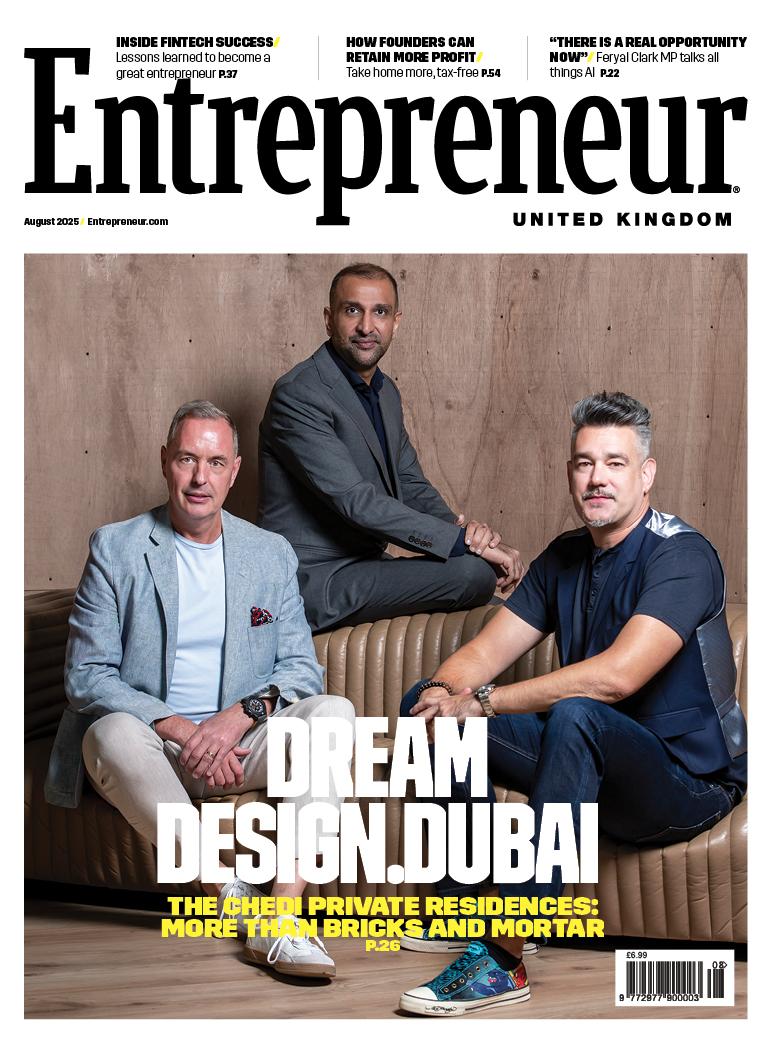

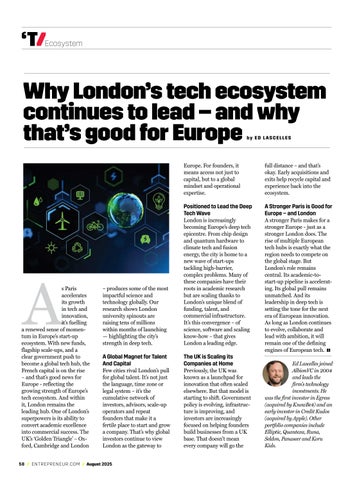


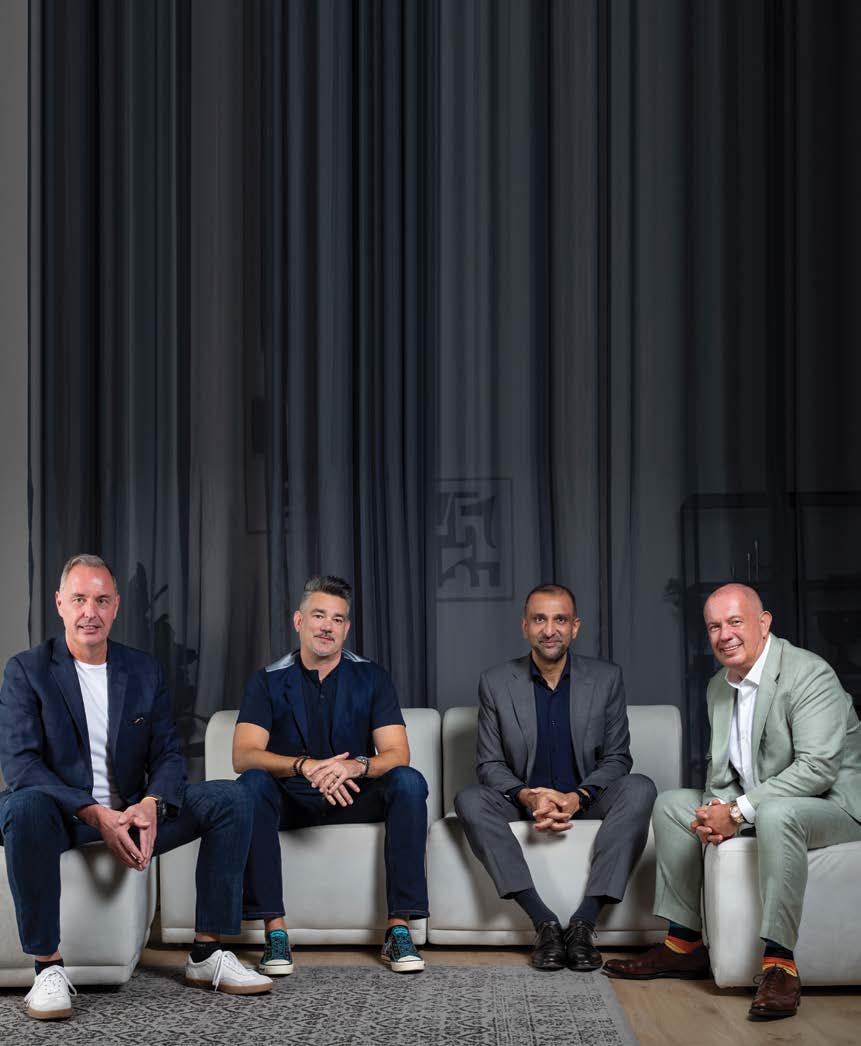


→ Feryal Clark, the UK’s Parliamentary Under‑Secretary of State for AI and Digital Government

58 Why London’s Tech Ecosystem Continues to Lead… … and why that’s good for Europe
18 Why Hiring Needs a Hard Reset
A Steven Bartlett-backed approach to recruitment as brand marketing
22 “There Is A Real Opportunity Now”
The UK’s Parliamentary Under-Secretary of State for AI and Digital Government on how AI is set to transform the UK
44 Why Climate Activism is the Next Big Market Tech innovation meets environmental urgency
47 Skills Over Schools Expertise, not degrees, will define careers
50 The ‘Return to the Office’ Myth Rethinking workspace culture postpandemic
34 Franchise Growth Hack
Why entering awards is a 12-month PR win
37 Inside Fintech Success Lessons learned to be a great entrepreneur
42 Eight Months In Growing pains and gains of a UK startup
8 Navigating the Raise Fundraising in a year no one wanted to write cheques
10 Watermarking the Future Datapatrol is boosting cybersecurity without compromising speed
FEATURES EDITOR Patricia Cullen patricia.cullen@bncb2b.com
CEO Wissam Younane wissam@bncpublishing.net
MANAGING DIRECTOR Rabih Najm rabih@bncpublishing.net
ART DIRECTOR Simona El Khoury
EDITORIAL TEAM Tamara Pupic, Aalia Mehreen Ahmed
MEDIA SALES MANAGER Olha Kovalova olha.kovalova@bncb2b.com
GENERAL MANAGER Daniel Malins daniel@bncb2b.com
REGIONAL DIRECTOR Andy B. andy@bncb2b.com
CONTRIBUTING WRITERS Omar Hamdi, Pip Wilkins, Brandon Reynolds, Dominic Dugan, Lisa Dickson, Ebere Akadiri, Ed Lascelles and Ariel Renous
SUBSCRIBE
Contact subscriptions@bncb2b.com to receive Entrepreneur United Kingdom every issue.
COMMERCIAL ENQUIRIES sales@bncb2b.com
Access fresh content daily on our website

Dubai is full of big moments, so when something truly breaks through, it changes everything. The Chedi Private Residences is one such rarity - a development that does not merely add to the skyline but recalibrates the very meaning of luxury in the city. Our cover story explores how this landmark project is pushing the boundaries of possibility in a city constantly reshaped by innovation. Elsewhere in the August issue: in a world where cyber threats move at the speed of code, unseen vulnerabilities in everyday tools are driving the next wave of security innovation. Another feature in this month’s issue zeroes in on exactly
that: Datapatrol, a rising force in data security, whose real-time screen watermarking technology is turning screens - the last great blind spot in cybersecurity - into a first line of defence.
My conversation with Farshad Nowshadi, a seasoned entrepreneur and investor, stands out for its clear-eyed insights that rise above the typical start-up rhetoric. In Inside Fintech Success - Lessons Learned to Become a Great Entrepreneur, he distils decades of experience into lessons worth noting.
It’s not just a must-read - it’s a masterclass. Also in this issue: an interview with AI Minister Feryal Clark, who shares exciting insights into the UK’s bold ambitions in the rapidly evolving world of artificial intelligence (AI) and highlights the areas where policy is actively advancing alongside this progress.
Elsewhere, we explore the shifting landscape of leadership, featuring women driving change in sectors still steeped in legacy and imbalance. There’s also a deep dive into why entering awards is a year-round PR win, along with a look at the myths surrounding the muchdiscussed “return to the office.” Founders will discover valuable insights - from savvy profit retention strategies to why the future job market will prioritise adaptability and skills over titles.
So whether you’re reading from a desk, a deckchair, or somewhere in between - welcome. This month’s issue presents expert insight across politics, business and culture.
Happy holidays,
Patricia Cullen Features Editor, Entrepreneur United Kingdom


Fundraising in a year no one wanted to write cheques by ENTREPRENEUR UK
STAFF
Closing a £5m funding round in a down market is no small feat. For Charlotte Lucy Hall, co-founder of background checking platform Zinc, the process was defined not just by the financial climate, but by a set of overlapping personal and professional pressures that made the experience unique. “Deciding when to disclose my pregnancy during our first funding round was one of the toughest decisions of my life,” she says. “My co-founder and I were also silently navigating a long, painful fertility journey. Balancing the intense emotional and physical exhaustion with the immense pressure to secure investment felt overwhelming at times.”
The backdrop was unforgiving. The economy had dipped, the tech bubble had burst, and high-profile bank collapses were unfolding mid-due diligence. “Very few firms were writing cheques, especially for first-time founders,” Hall recalls. But investors ultimately bought into Zinc’s mission to transform a frustrating process into something faster, more transparent, and more empowering. “Our candidate-centric
solution is redefining how background checks are done across many industries with particular success in finance, healthcare and education sectors,” Hall explains. “In today’s competitive landscape, hiring delays can cost businesses both valuable time and top talent. We showed them that our technology gives HR and talent professionals back what matters most: their time.”
Zinc’s traction played a

WE NEED OPEN, HONEST CONVERSATIONS - BETWEEN FOUNDERS, INVESTORS, AND TEAMS - ABOUT THE REALITY OF PREGNANCY AND NEEDING TIME TO CARE FOR A NEW BABY. THESE ARE NATURAL LIFE EVENTS THAT SHOULD BE CELEBRATED, NOT TREATED AS TABOO”
key role in convincing investors to sign on. From early-stage start-ups like Marshmallow to fintech giants like Revolut and established names like Trainline, the company’s client list reflected both adaptability and demand. “The Zinc solution isn’t one-size-fits-all; it’s tailored to each customer’s unique structure and goals. But the consistent benefit for every client is easing the workload for HR teams and reducing stress for new hires during the background check process.”
The difficult market was only part
Honestly, my own expectations were far harder to navigate than any investor scepticism. As founders, and especially as women, there’s often this intense pressure to prove ourselves by carrying every burden simultaneously”
of the challenge for Hall. She also had to navigate the delicate decision of when to tell investors she was pregnant. At the same time, she and her co-founder were dealing with a long and painful fertility journey. Balancing these personal struggles with the pressure to secure investment created a constant sense of overwhelm. Hall waited until her second trimester before sharing the news. “By then, we felt a bit more secure in the pregnancy. Thankfully, our investors were incredibly supportive - it was actually very reassuring and truly reconfirmed that we had chosen the right partner in AVP.”
Yet for all the concerns about external perceptions, she found the hardest part came from within. “Honestly, my own expectations were far harder to navigate than any investor scepticism,” she reflects. “As founders, and especially as women, there’s often this intense pressure to prove ourselves by carrying every burden simultaneously.” The lesson, she says, is about pace - and permission. “Giving yourself permission to slow down when you need to, and trusting that progress doesn’t always look like constant motion, is incredibly powerful. It’s okay to take a breath and slow down.”
Hall is open about the additional challenges that came from not having a typical founder background. “No elite university affiliations or Big Tech names,” she notes. “The absence of those credentials meant we faced an uphill battle for credibility, resulting in more rigorous vetting and outright rejections than we
might have otherwise.” Rather than attempting to compensate, Hall leaned in. “It pushed us to articulate our true differentiators: our unparalleled understanding of the problem we’re solving, the clarity of our long-term vision, and our unwavering, mission-first ethos.” That approach not only resonated - it helped redefine the conversation. “This wasn’t about trying to fit a mould; it was about amplifying what made Zinc genuinely unique and compelling.” Now, having made it through both the fundraise and early motherhood, Hall wants the ecosystem to evolve. “We need open, honest conversations - between founders, investors, and teams - about the reality of pregnancy and needing time to care for a new baby. These are natural life events that should be celebrated, not treated as taboo.”
Too often, she says, female founders are forced into an impossible choice. “Currently, women often can’t win: judged for returning ‘too soon’ or for taking ‘too long.’ This shouldn’t be a forced choice.”
Zinc’s funding round may have concluded, but its broader significance has only just begun. It suggests that the next iteration of start-up culture - if it’s going to be more inclusive - must reckon with the whole human behind the founder. And that itself could be a marker of progress. True flexibility, Hall says, must be more than a slogan. “We need a cultural shift that respects these decisions, encourages true flexibility, and provides concrete support, not just platitudes.”
In a digital age where screens have become the silent leak in corporate armour, Datapatrol’s real-time watermarking technology is turning the last blind spot in cybersecurity into a frontline defence - without slowing a single keystroke.
by ENTREPRENEUR UK STAFF

At Infosecurity Europe, where the cybersecurity world converges, Datapatrol, a pioneering data security firm focused on closing the overlooked gap of screen-based data leaks, unveiled a revolutionary technology - screen watermarkingthat promises to transform how businesses protect sensitive data without sacrificing speed or ease of use.
Cybersecurity budgets across the world have ballooned into the billions, and yet, sensitive data continues to slip through the cracks. The conventional wisdom has long been to fortify digital perimeters - encrypt files, monitor networks, and build firewalls strong enough to repel the most sophisticated attacks. But what if the greatest vulnerability isn’t lurking in distant servers or hidden code, but rather in the very screens users stare at every day? This is the insight that underpins Datapatrol, a rising star in data security. The company has taken an unconventional approach: if organisations are investing heavily to protect data at rest and in transit, then why overlook what happens when that data is
displayed on screens?
Loay T. Hussain, Managing Director at Datapatrol, puts it plainly:
“A lot of people we spoke to at Infosec told us the same thing, they had never really thought about how exposed screens can be. Once they saw how simple it is to add that extra layer of protection, it just clicked. It’s not about adding another heavy tool, it’s about fixing a gap that’s been ignored for too long.”
Datapatrol’s solution is elegant in its simplicity and powerful in effect. Unlike static watermarks that merely add a faint logo or text, Datapatrol’s technology overlays dynamic, real-time identifiers directly on live screen content. Usernames, IP addresses, department info, session times - all become visible
on screen, invisibly embedded in the everyday work flow. It delivers a significant impact.
Screens, once a security blind spot, become a smart safeguard. Every screenshot, every photo, every screen recording instantly carries identifiable information that ties it back to the user. This doesn’t just deter accidental leaks, it makes deliberate theft far riskier.
The invisible vulnerability It’s easy to overlook how exposed data can be once it leaves the secure environment of the network and appears on a user’s screen. Yet this is precisely when data is most vulnerable. Screens can be photographed with smartphones, screenshots can be taken, and remote desktop sessions can be compromised - all
“A lot of people we spoke to at Infosec told us the same thing, they had never really thought about how exposed screens can be. Once they saw how simple it is to add that extra layer of protection, it just clicked. It’s not about adding another heavy tool, it’s about fixing a gap that’s been ignored for too long”
avenues often overlooked by traditional cybersecurity defences. With hybrid working becoming the norm and
collaboration spreading across multiple devices and locations, this risk has never been more pressing. Protection strategies that

once centred on physical offices and internal networks now have to account for users dispersed around the globe.
In this context, Datapatrol’s screen watermarking emerges not as an afterthought, but as a critical component of a holistic security posture. It bridges the gap between technology and human behaviour, a recognition that the ‘human factor’ remains the weakest link in many organisations’ defences.
A culture of accountability Datapatrol’s innovation goes beyond technology however; it’s about shaping corporate culture. By embedding traceable watermarks into every screen, it cultivates a sense of accountability among employees and contractors.
When the identity of the viewer is subtly but clearly displayed, it reminds users that sensitive data isn’t just abstract - it’s something they are personally responsible for protecting.
This subtle psychological nudge is an invaluable complement to compliance training and internal policies. Instead of relying solely on annual workshops or dense manuals that are quickly forgotten, the watermark serves as a continuous, visible reminder. It turns abstract rules into a practical, everyday reality. This shift in mindset is critical. Protecting data is everyone’s responsibility. Security can’t be left to IT alone - it has to be a shared mindset that runs through the entire organisation.
“
Screens, once a security blind spot, become a smart safeguard. Every screenshot, every photo, every screen recording instantly carries identifiable information that ties it back to the user. This doesn’t just deter accidental leaks, it makes deliberate theft far riskier”

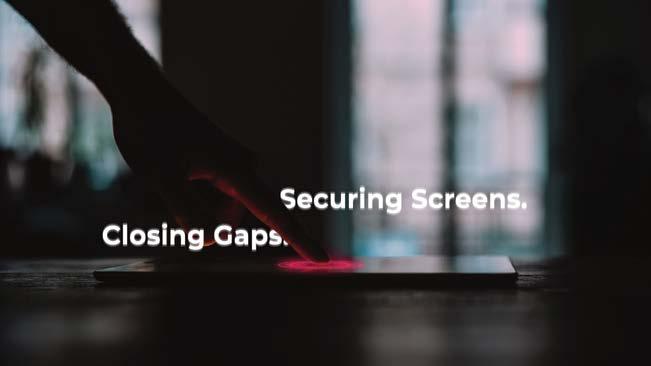
One of Datapatrol’s greatest strengths lies in its unobtrusive design. The watermark operates passively; users don’t have to click, activate, or manage anything. Once deployed, the watermark is always present when needed - a silent guardian working in the background without disrupting productivity.
This ease of integration was a key factor in Datapatrol’s growing success across Europe. At Infosecurity Europe, the company’s presence drew CISOs, IT managers, and compliance officers eager to see the technology in action. Many were surprised at how seamlessly it fit into existing workflows without creating additional burdens.
For many organisations struggling to balance rigorous security requirements with the need for agility, this is a gamechanger. Datapatrol proves that effective protection
does not require cumbersome or complex tools that slow down teams; instead, it shows that even a simple, well-designed solution can close the gaps left by traditional defences.
Datapatrol’s momentum is clear. As hybrid working cements itself as the default and data regulations tighten, the company is rapidly expanding its footprint across the continent. Its client base already spans diverse sectors - from finance to healthcare, from fintech startups to household names — reflecting the broad relevance of its approach.
With cybercrime evolving constantly, the ability to adapt quickly and plug overlooked vulnerabilities is essential. Datapatrol’s screen watermarking offers organisations a proactive tool to deter breaches before they happen. The company’s growth is more
than a business success; it signals a broader shift in how organisations think about data protection. It calls for an integrated strategy that combines technology, human awareness, and cultural change.
Looking ahead
As data security challenges multiply, so too does the need for innovation beyond the obvious. Datapatrol’s journey highlights a vital lesson for businesses and cybersecurity leaders alike: sometimes the most effective solutions arise not from layering on more complexity, but from reimagining existing problems.
In a world where data is a company’s most valuable asset, protecting it requires vigilance at every level - including the screens we often take for granted. Thanks to companies like Datapatrol, that invisible frontier is finally getting the attention it deserves. In an
era when breaches can cost millions, Datapatrol’s screen watermarking turns every screen into a traceable safeguard - making data protection personal, visible, and accountable.
5 reasons why screen security matters - and how Datapatrol leads the way
}1. SCREENS ARE A MAJOR DATA LEAK RISK
Even with strong firewalls and encryption, sensitive information is vulnerable the moment it’s visible on a screen. Screens create a blind spot often ignored by traditional cybersecurity.
}2. HYBRID WORK MAKES IT WORSE
Remote working means employees access data across multiple devices and locations, increasing the risk that screenshots or photos could be taken without authorisation.
}3. DYNAMIC WATERMARKS FOR REAL-TIME PROTECTION
Datapatrol’s screen watermarking overlays unique identifiers - like username, location, and IP addressonto live screen content, making every screenshot traceable back to the user instantly.
}4. SEAMLESS INTEGRATION WITHOUT DISRUPTION
Unlike clunky security software, the watermark runs passively in the background without user action, keeping workflows smooth while adding a powerful layer of accountability.
}5. A CULTURE OF RESPONSIBILITY
By making the sensitivity of displayed data visible at all times, Datapatrol helps build a security-first mindset across teams - turning every employee into a guardian of company information.
Women navigating leadership and change in an industry still marked by inequality and tradition.
by PATRICIA CULLEN
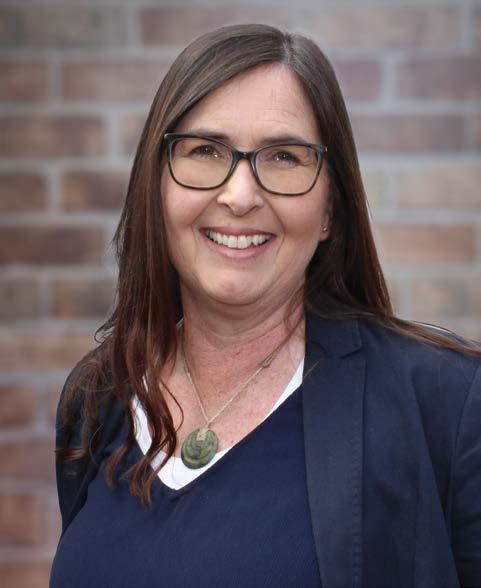
↑ Lisa Miles-Heal, CEO of high growth SaaS company Silverfin
Tech leadership used to be a boys’ club with a secret handshake - an exclusive ritual women weren’t part of. Now, women are in the room, sealing deals and closing million-pound rounds with a different kind of grip. Leaders like Lisa Miles-Heal, Danae Shell and Caroline Carruthers demonstrate that success in tech isn’t just about innovation - it demands a fundamental reshaping of power, culture, and vision. They aren’t simply changing who sits at the table - they’re changing how the table itself is built.
Lisa MilesHeal’s leadership sits at the intersection of two persistent fault lines in the tech sector: rapid innovation and entrenched gender inequality. As CEO of Silverfin, a UK based financial technology company, Miles-Heal operates in a space where women remain significantly underrepresented - particularly in senior roles within enterprise technology. Yet her presence at the helm challenges the longstanding norms of who gets to lead in tech, and how. In a sector still defined by structural hurdles, Miles-Heal’s rise stands as an unmistakable challenge to the established order.
“I wish more women knew that the skills and experience they bring to the table are as equally valuable as anyone else’s,” she says. “It’s easy to fall into the trap of comparing yourself to the majority, thinking if you don’t do things their way, you’re doing it the wrong way. But your unique
style and approach are your strengths. Your powerful differentiators will serve you well.” Miles-Heal’s leadership journey is a quiet rejection of conformity - and a celebration of difference. “Starting a business takes resilience and belief in yourself. One of the best ways to build that self-belief is by finding role models who show you different paths to successpeople who prove it’s okay to lead authentically.” Authenticity, for her, isn’t just a management strategy; it’s survival. “My inspiration comes from other female leaders. The CEO of Visma is one - she came from a HR background, which is atypical for a tech CEO. Another role model is Dawn Marriott, who’s shown me you can stay true to yourself even when moving from operator to investor. These women prove there’s no one ‘right’ way to lead.”
That kind of perspective has helped guide Silverfin’s rise - a company now
regarded as one of the leading platforms transforming financial data workflows for accountants and finance teams. But when asked what decision made the biggest impact on the company’s growth, her answer is disarmingly straightforward.
“Growth is rarely driven by a single factor,” she says. “But, I’d say gaining a much better handle on our core metrics was crucial. Having clear visibility into your numbers provides you with the clarity to identify exactly what is needed for focus and improvement.”
The focus on fundamentals isn’t just a business cliché. It’s a discipline.
“Without being clear on your metrics - whether that’s ARR growth, EBITDA, or customer-related numbers — you’re at a serious disadvantage. You can run a business on gut feel, experience, and a strong product vision, but without data, you can’t be sure if what you’re doing is actually moving the needle.”
The key metrics MilesHeal watches most closely are telling: employee en-
gagement scores (eNPS), employee numbers (EMPs), customer net promoter scores (NPS), ARR growth, and EBITDA. These give a rounded picture of Silverfin’s business health and growth potential. But metrics alone don’t define culture - or leadership. When asked what assumption about leading in tech she’s found to be untrue, the CEO doesn’t hesitate.
“One big assumption I’ve found is that you must have a technical background to be a leader in tech,” she says. “That’s quite a funny assumption because the landscape is shifting so much. With the rise of AI and evolving tech, leadership is circling back to focus less on coding skills and more on understanding the problem you’re solving and communicating clearly - whether that’s with people or AI tools.”
It’s a shift that could - and should - rewrite the rules of who gets to lead. “What’s becoming absolutely vital are the soft skills and emotional intelligence. These are the skills that women often excel in, and I like to
What’s becoming absolutely vital are the soft skills and emotional intelligence. These are the skills that women often excel in, and I like to think AI could be a feminist intervention shifting the power towards these strengths”


think AI could be a feminist intervention shifting the power towards these strengths. Imagine a world where women lead because the future of tech values empathy, communication, and nuanced understanding as much as technical know-how. That would be powerful and honestly, I hope it becomes reality.” That imagined future is something Miles-Heal is actively building - one initiative, one hiring policy, one conversation at a time. “It starts with yourself - building confidence and being your own best advocate. From there, it’s about supporting the people closest to you - friends,
family, and colleaguesand being a positive role model.” Internally at Silverfin, progress has been tangible. “We’ve achieved 50% gender equity both in our leadership team and on our board. We’ve also taken practical steps like launching a women’s network and peer-to-peer mentoring programme where women mentor other women, which is separate from our broader mentoring initiatives.” That peer support is mirrored externally, too. “Looking beyond the business, we actively advocate for women in our customer base by hosting forums in Belgium and the UK for
→ Caroline Carruthers, CEO at Carruthers and Jackson
senior women in accounting technology.”
Representation, she notes, isn’t an afterthought. It’s deliberate. “We also support womenfirst events like the Women’s Tour de France and the Women’s Rugby World Cup, consciously choosing to prioritise female-focused activities and ensuring gender balance in speakers at our events and paid participation.” Miles Heal understands that progress sometimes means disrupting the ingrained rules that have gone unchecked for too long. “A big focus for me personally has been pushing for genderneutral language across
tech and accounting. This means actively challenging the use of long-standing phrases like ‘man days’ or defaulting to ‘guys’ when referring to groups of people. It’s a small but meaningful way to foster inclusivity and help change the culture for the next generation of women in tech.” If there’s a thesis to Miles-Heal’s leadership, it might be this: change begins close to home, but its impact can ripple outward. “Overall, I believe creating opportunities is about focusing on the immediate environment first - yourself, your company - and then gradually expanding your impact outward, like ripples in a pond.”
Joining this chorus of female tech leadership is Danae Shell, co-founder and CEO of Valla, a workplace dispute resolution platform. Named one of the UK’s Top 50 Female Entrepreneurs by Innovate UK, Shell brings a complementary perspective on women in tech and entrepreneurship.
“I wish more women knew that they can start a business in tech - many women I’ve met assume that they need deep technical knowledge to start a tech business, and with Generative AI lowering technical barriers every day, this has never been more untrue,” Shell says. “I want women to know that the tech industry needs their deep expertise in their own fields, and that the technology part is getting easier and easier every day.”
Her decision to “go all-in on AI” in 2023 marked a pivotal moment for Valla’s growth. “We saw Generative AI emerge and knew immediately that it was going to be a game-changer for the industry we were in, legaltech. I set the team the goal of delivering ‘one unit of magic’ using AI - the tech was so new that we didn’t even know what it could and couldn’t do yet. The company became an AI R&D department overnight and we unlocked huge amounts of value that are now built into our most popular products.” For Shell, the toughest part of leadership hasn’t been the fast pace or the demanding workload, but rather “managing myself and making consistently good decisions even under high uncertainty and stressful situations. It’s a tough mix of trusting your gut and staying open to challenge, especially when things are moving faster and faster.”
On fostering the next generation of female entrepreneurs, Shell recalls how mentorship shaped her journey. “A lot of women gave their time to help me get where I am today - I remember one well-known entrepreneur I had never met called me in the few minutes before a flight to give me some critical advice, which was exactly what I needed at the time.” Following their lead, she now actively supports groups like AccelerateHer and Pathways Forward, “to give support, large and small, to the next cohort of female entrepreneurs.”
Caroline Carruthers, CEO of Carruthers and Jackson, a Darlington based data consultancy, adds yet another dimension to the conversation about women in tech leadership. “I
wish more women knew how supportive other female business leaders will be. This is something that really surprised me when I started Carruthers and Jackson, especially as the support I received even came from women who ran companies that were competitive to mine.” She acknowledges the challenges of being a female founder in tech, but stresses solidarity. “It’s still hard to be a female founder, especially in an industry like technology, which is why it’s so valuable that we offer each other a lot of support. Rather than being adversarial, we want more women to join our world.”
Reflecting on her own growth, Carruthers reveals the mindset shift that propelled her forward. “My company’s growth really took off when I realised the need to toughen up. It’s impossible to please everybody and to be a business leader you must be able to make tough decisions and, crucially, be comfortable with the decisions you make. You can’t keep saying sorry and you can’t let the decisions you make keep you awake at night. Without this mindset, your business isn’t going to grow.”
I WISH MORE WOMEN KNEW THAT THEY CAN START A BUSINESS IN TECH - MANY WOMEN I’VE MET ASSUME THAT THEY NEED DEEP TECHNICAL KNOWLEDGE TO START A TECH BUSINESS, AND WITH GENERATIVE AI LOWERING TECHNICAL BARRIERS EVERY DAY, THIS HAS NEVER BEEN MORE UNTRUE”
She also emphasises the strategic use of networks. “Another important decision I made was to draw on my network, but to do it in the right way. There is a perception that your network doesn’t want to be put upon, but really, it’s about giving them an option - teaching people what you do and letting them decide if it’s right for them.” Carruthers challenges a common myth about leadership: “I assumed that when you get to a certain position in your career, you stop suffering from imposter syndrome, but this isn’t the case. No matter where you are, everyone still suffers, so this is something you need to learn to work with.”
Her commitment to nurturing future talent is clear. “Carruthers and Jackson runs an annual Summer School for Data Leaders, a free programme designed to give future data leaders the skills they need to succeed. While the course is open to men and women, we have so many promising female students every year, and I feel honoured to be able to help them along their paths.” Beyond that, Carruthers mentors through Women in Data, “a community focused on advocating for and supporting women in the data field. As well as mentoring, within these sessions, I try to coach future female leaders on working with their strengths and making the best career for themselves.” Before starting out, she suggests speaking to someone who’s done it before — a step she wishes she’d taken herself. “I’ve learned so much since starting my businesses that I didn’t even know I needed to know. If I’d have spoken to my peers, some of these learnings wouldn’t have come as such a painful surprise!”
Miles-Heal, Shell, and Carruthers are driving a new era of tech leadership. Their insights highlight not just the challenges women face, but the power of community, courage, and conviction to transform an industry long overdue for change.
Forget cold calls and CV databases. Leo Harrison’s Chapter 2 is building a recruitment model that looks more like brand marketing than admin. by
ENTREPRENEUR UK STAFF
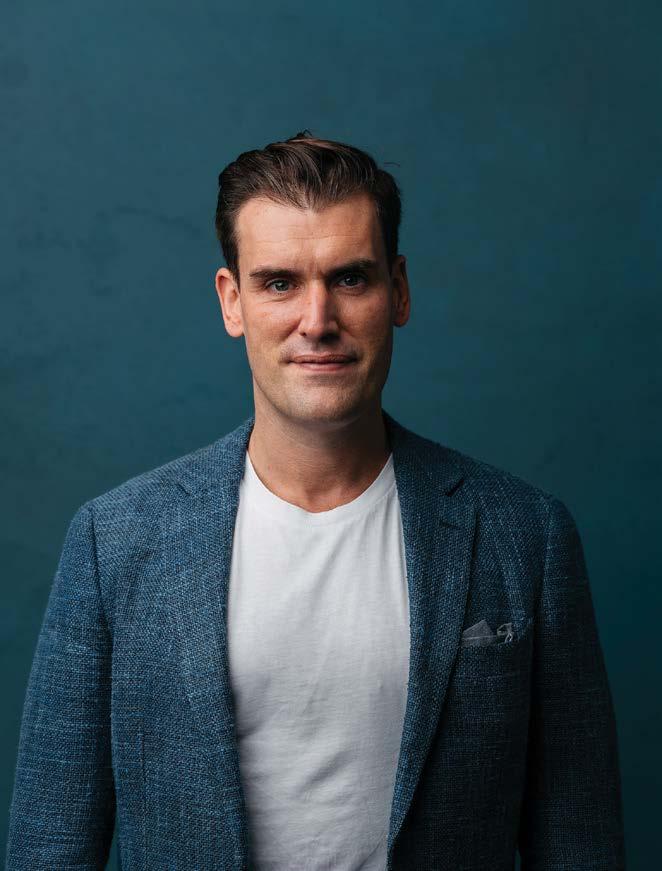
For decades, recruitment has been treated as little more than a numbers game - a transactional process focused on filling roles, not futures. But Leo Harrison is betting on a very different vision. As the founder of Chapter 2, a recruitment platform that straddles technology, talent strategy and employer branding, Harrison believes the old models are broken beyond repair. And he’s not alone. With Steven Bartlett backing the mission, the future of hiring might finally be catching up with the future of work. Entrepreneur UK finds out more.
You’ve scaled teams at hypergrowth pacewhat’s the first talent mistake fast-growing start-ups make?
From my time building OLIVER Agency and a number of VC and PE backed businesses, I’ve learned a lot about scaling teams at a hyper growth pace, and if there’s one talent mistake fast-growing start-ups tend to make, it’s rushing
the scaling process itself. At OLIVER, this was our biggest lesson. We quickly realised that trying to fill roles too quickly often led to compromises in talent quality or cultural fit. Instead, we found success by strategically using known and trusted freelancer communities as an interim solution. We treated these freelancers and an extension of our team. This ultimately allowed us to maintain our operational pace while giving us the crucial time to thoroughly vet and find the absolute best talent on the market to build our resilient, high-quality, and high-energy teams. It’s also vital not to throw new starters into new client environments, but

→
Leo at Linkedin with Steven Bartlett
“ FOUNDERS
CULTURES PEOPLE WANT TO RETURN TO MUST, FIRST AND FOREMOST, UNDERSTAND THAT TODAY’S WORKFORCE, PARTICULARLY GEN Z, IS DIGITALLY SAVVY, PURPOSEDRIVEN, AND INCREDIBLY CONFIDENT IN SAYING “NO” TO OPPORTUNITIES THAT DON’T ALIGN WITH THEIR VALUES”
rather to prioritise candidates who truly understand the companies’ methodology and DNA. This enables companies to continuously upskill existing employees and ensure they’re aligned with the culture and flexibility that comes with rapid growth. How does re-engaging alumni and ‘silver medalists’ change the game for cost-effective hiring? Recruitment is often transactional and linear in nature. We spend a great deal of time, effort and often money, to reach and engage our targeted audience and secure the best talent. But once that all important hire is made, the job of the recruiter is often considered redundant. At Chapter 2, we look at talent differently as we help our clients move from recruitment to a full talent strategy, looking at
talent in a way that optimises hiring and workforce planning through our Advisory services. There are several categories for talent and although the best individual will often secure the role, that doesn’t mean that our runner up wasn’t equally as suitable. This category is often referred to as “The Silver Medallist”. You also get ex-employees or “Alumni,” which, for the majority of companies, disappear without a trade, never to be seen again, even though they possess the necessary skills, context and IP of the business at hand and how they operate. Now if we were to presume that the majority of professionals will remain within their chosen field for a number of years and also assume that those who came to you once, did so for a reason and may again, why wouldn’t you
→ Steven Bartlett and Leo Harrison

look to engage with these talent communities in a more meaningful way? In particular, engaging talent in a less linear and more cyclical manner. This is exactly why “Boomerang” and “Alumni hiring” initiatives are considered to be one of the fastest, most cost-effective hiring methodologies we can employ. In fact, each boomerang hiring initiative we have run at Chapter 2 has led to our clients having successfully re-hired up to 20% of their leavers within 12 months. This is because we actively look at those who might not be quite right for one role but may be perfect for another, up-skilling existing team members, and nurturing ongoing relationships with those who have left.
What did traditional recruitment models get wrong - and how is Chapter 2 rewriting the script?
Traditional recruitment models, especially contingent recruitment and outdated RPO, got a lot wrong by being overly transactional and failing to truly
engage talent strategically. I’ve always felt they missed a crucial trick: viewing recruitment as a mere administrative process rather than a dynamic, marketing-led initiative. At Chapter 2, we’re completely rewriting that script. We don’t just “embed talent” within our clients’ environments; we back that service with something truly unique, our very own engine called ‘Candidate Conversion Content’. This means we’re actively using marketing “nudge theory” and creating high-quality, employee branding content to make our clients incredibly attractive to top candidates. We also leverage our own proprietary technology, a platform which we’re announcing very soon, which also gives us unparalleled access to active talent pools, understanding precisely where the talent is and what the competitive landscape looks like before we even start recruiting.
In a talent market driven by flexibility and wellbeing, how can founders
design cultures that people want to return to?
The talent market has profoundly shifted, and from my perspective, the power balance has undeniably swung towards the candidate, especially for top-tier talent. This isn’t a temporary blip; it’s a fundamental change driven significantly by Gen Z’s influence and a broader desire for more than just a paycheck. Founders designing cultures people want to return to must, first and foremost, understand that today’s workforce, particularly Gen Z, is digitally savvy, purpose-driven, and incredibly confident in saying “no” to opportunities that don’t align with their values. This ultimately indicates founders need to build companies that people are genuinely proud to work for, where the job fuels their life rather than just finance it. This means cultivating environments that prioritise wellbeing and flexibility, offering authentic, meaningful work experiences, and genuinely embedding purpose into the company’s
STEVEN BARTLETT HAS PREVIOUSLY SPOKEN ABOUT HOW ‘YOUR NETWORK IS YOUR NET WORTH’ - THIS IS SO TRUE WHEN IT COMES TO TALENT ACQUISITION”
DNA, because in this new landscape, attracting and retaining the best talent hinges on offering a culture that truly resonates with modern expectations.
From an investor’s perspective, what do you think made Chapter 2 stand out to someone like Steven Bartlett?
Having known Steven Bartlett for a few years now, and based on many of our chats in the lead up to his investing into Chapter 2 last year, I believe the company stood out to him because he truly understood our mission and could see that we’re not just another recruitment agency. We’re a genuine disruptor in a field which he also saw was broken. Bartlett often speaks to traditional recruitment’s pain points, describing approaches as being expensive, having misaligned incentives and not understanding each company’s culture - all of which are precisely the problem I founded Chapter 2 to solve. Our model, built on “People, Process, and Technology,” directly addresses these issues by offering scalable solutions that integrate like an in-house team but with the agility of an agency. I also think he recognised our core philosophy: that
talent acquisition is fundamentally a marketing challenge, not just a transactional one, and our data-driven approach is truly rewriting the script on how businesses attract and retain the best people. In fact, Barlett has taken this commitment to recruitment to heart, applying it directly to his own company’s process at Flight Story. He has recently built a new cultural quiz survey, meticulously crafted to assess the companies’ alignment with candidate’s values, all of which
large number of the talent founders are looking for, aren’t in recruiters’ databases, they’re within the network of the team, so use that to cultivate talent pools. This has multiple benefits such as eliminating the recruitment fee and engaging known talent rather than unknown candidates - ultimately leading not only to great hires but hires that stay for the long term.
What Harrison offers isn’t disruption for its own sake, but a recognition that recruitment, as it stands, no longer fits
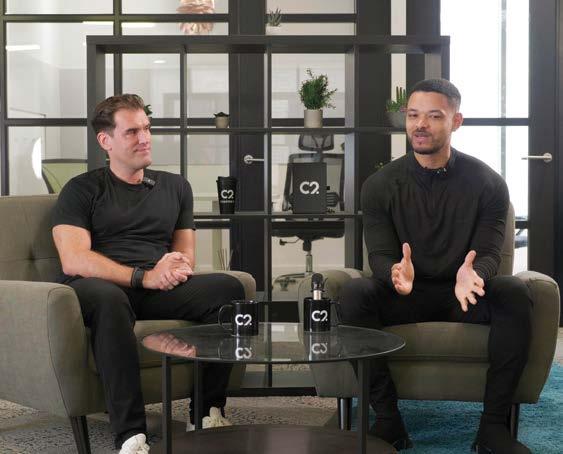
→ Chapter 2 secured backing from Steven Bartlett to modernise the current outsourced recruitment model
complete before even reaching the interview stage.
What one shift would you recommend every founder make in their hiring strategy today?
One shift that I’d recommend any founder of a scaling business to do is to establish the power of your team’s network. Bartlett has previously spoken about how ‘your network is your net worth’ - this is so true when it comes to talent acquisition. I guarantee that a
the shape of modern work. In a landscape where culture and purpose increasingly outweigh perks and ping-pong tables, Chapter 2 treats hiring not as a funnel, but as an ecosystem - one that values continuity over churn, and long-term thinking over short-term placement. If the traditional model feels broken, it’s because it was never built to last. Harrison’s approach is a compelling start to a smarter, more sustainable conversation.
→ Feryal Clark, the UK’s Parliamentary Under‑Secretary of State for AI and Digital Government

Feryal
PATRICIA CULLEN
Artificial intelligence (AI) is often cast as a double-edged sword - brimming with potential but shadowed by risk. In the UK, that tension is being met head-on with a distinct strategy: championing regulation not as red tape, but as a catalyst - a way to unlock innovation safely, responsibly, and at scale. For Feryal Clark, the UK’s Parliamentary Under-Secretary of State for AI and Digital Government, and the minister leading this effort, AI
represents a genuine chance to revitalise overburdened public services and position the UK as a global leader in groundbreaking innovation.
While tech giants grab the headlines and global competition heats up, Clark remains focused on a more pragmatic priority. She is determined that the UK’s approach to AI goes beyond just chasing innovation - aiming also to protect and enhance people’s lives. And central to that, she insists, is regulation that does not suffocate the
“ THE UK HAS LAUNCHED A REGULATION INNOVATION OFFICE TO STREAMLINE REGULATION, CUT RED TAPE FOR BUSINESSES, AND
very industry it seeks to steward. “We are currently in the process of developing legislation which will prepare the UK for AI security risks. We are really keen to make sure that it also drives innovation and investment. We are ensuring we can safely use the opportunities of AI for years to come. ”
The message is clear: it’s about keeping the UK ahead - but not at any cost. “The UK has launched a Regulation Innovation Office to streamline regulation, cut red tape for businesses, and accelerate the introduction of new technologies to the UK market,” she says. However, it’s not just about what’s new. Clark is quick to point to the strength of the UK’s existing system. “The UK has some of the best regulators, currently delivering sector-specific regulations and tailored advice,” adding that “the country is in a good place when it comes to regulation.”
But with a field as fast-moving as AI, the government knows regulation has to continue to evolve. A key step, the minister says, has been the creation of a new body to help accelerate the market introduction of emerging technologies with greater efficiency. This initiative aims to create a more agile regulatory environment that keeps pace with rapid technological advancements. “It’s already looking at a whole host

THE HOSPITALS ARE USING AI TO IMPROVE STROKE OUTCOMES FOR PATIENTS. THEY’RE USING AI TO WORK OUT WHICH PATIENTS CAN RECEIVE TARGETED TREATMENT TO BREAK DOWN BLOOD CLOTS AND THEREFORE IMPROVE THE QUALITY OF LIFE.”
of areas, including AI in health care and autonomous technologies,” she adds.
While much of the political debate around AI focuses on geopolitics and ethics, Clark often returns to a more local lens: the impact on schools, hospitals, and overstretched councils. AI is not just the concern of Silicon Roundabout or Big Tech - it’s something
already changing daily life.
“Everyone is looking to utilise AI in one way or another. When we look back through human history, there is no emerging technology that hasn’t had a transformative impact on our economy in some shape or form. I think the same is true of AI.”
Already, she notes, practical examples of AI are emerging - often away
from the headlines, but deeply embedded in everyday systems. “We’re already seeing AI being adopted in classrooms by teachers to help them plan lessons and personalise learning experiences for children. In healthcare it’s being used to deliver new drug breakthroughs that are helping us beat diseases. And also it’s supporting the work of doctors to improve patient
care rather than replacing them.” She highlights one case in Devon. “The hospitals are using AI to improve stroke outcomes for patients. They’re using AI to work out which patients can receive targeted treatment to break down blood clots and therefore improve the quality of life.”
But perhaps where she speaks most passionately is within the public sector, where she spent years before entering Westminster. She recalls her time working in local government, where colleagues endured 14 years of austerity. The relentless budget cuts left
the public sector stretched thin and struggling long before she arrived. Now, she says, technology could be part of the recovery. “There is a real opportunity to support the public sector with the use of AI to take the pressure off - providing staff more time to do what they are really there to do. There are huge opportunities where AI will genuinely transform the public sector, looking towards a time where there will be no more postcode lotteries.” She frames it not in terms of job losses, but job support. “I think it’s important to realise that disruption doesn’t necessarily have to mean negative change.” Forty years ago, many of today’s jobs didn’t exist - and the same will be true forty years from now. The future workforce will include roles we can’t yet imagine. “I think we
should see it not as a replacement, but as support for the workforce - to help them do better and bring enjoyment back into their jobs.” In social work, for example: “Instead of spending three or four hours typing notes
and looking at the actions, they can use AI for that dictation.” It will free up time, better utilised elsewhere. Reflecting on AI, Clark describes it as a general-purpose technology - one with the potential to touch and
transform every corner of society.
Despite the government’s ambition, the competitive global landscape is real - and crowded. But Clark insists the UK remains one of the best places to

build and grow in the AI space. In the first half of 2025, UK AI start-ups attracted a record $2.4bn in venture capital (VC) - accounting for 30% of all VC funding. It signals a clear and growing appetite to invest in the UK’s tech future. “We are building up our AI sector to create an environment which supports companies of all shapes and all sizes to grow whilst putting British expertise at the heart of transformative new breakthroughs.” WE

DEFINING A NEW BENCHMARK IN BRANDED LUXURY
by ENTREPRENEUR UK STAFF

In a city famed for architectural daring and hospitality excellence, Dubai is no stranger to ambition. But every so often, a project emerges that feels like a genuine inflection point. Rising elegantly from the city’s core along Sheikh Zayed Road, The Chedi Private Residences is not merely another branded tower—it is a recalibration of luxury itself. Seamlessly integrating elevated architecture, wellnessdriven design, and the DNA of world-class hospitality, this landmark development is rewriting the rules of residential excellence.

Behind this vision stands a team of remarkable collaborators: property developer Mahesh Kalwani, Vice Chairman of Al Seeb Properties; visionary architect Bruno Guélaff, design director of Studio Bruno Guélaff and partner at BG Group; global hospitality leader Stephan Schupbach, CEO of Chedi Hospitality; and luxury design veteran Mark Burns, Chief Design & Construction Officer at
OUR PORTFOLIO,” SAYS MAHESH KALWANI, “BUT INTEGRATING HOSPITALITY PRINCIPLES
Chedi. Together, they’re crafting what many believe will be one of the most iconic residential addresses in Dubai.
“The Chedi Private Residences is a bold step forward,” asserts Mahesh Kalwani. “It’s not just a new project; it’s a new vision for Al Seeb Properties. This marks our evolution into the ultra-luxury segment, and with it comes an entirely new level of ambition and expectation.”
does the discerning global resident of tomorrow really want?”
Kalwani points to a key turning point: “Our expansion into commercial properties broadened our portfolio. But integrating hospitality principles into our real estate offering—that was pivotal. It changed how we thought about customer experience, even in residential formats.”
“We recognized a significant shift in luxury homebuyers’ preferences—increasingly, discerning buyers seek not just premium physical spaces but
“IT’S NOT JUST A NEW

With over 30 years of experience building retail destinations and commercial spaces under the Al Safeer Group umbrella, Kalwani’s move into branded luxury residences is both strategic and emotional. “This wasn’t about entering a trend. It was about answering a question: what
comprehensive lifestyle experiences with the assurance of world-class service standards.
My background spanning both retail and hospitality sectors provided unique insights into this trend. The branded residence model perfectly bridges real estate development with hospitality excellence—a space where we saw
}}

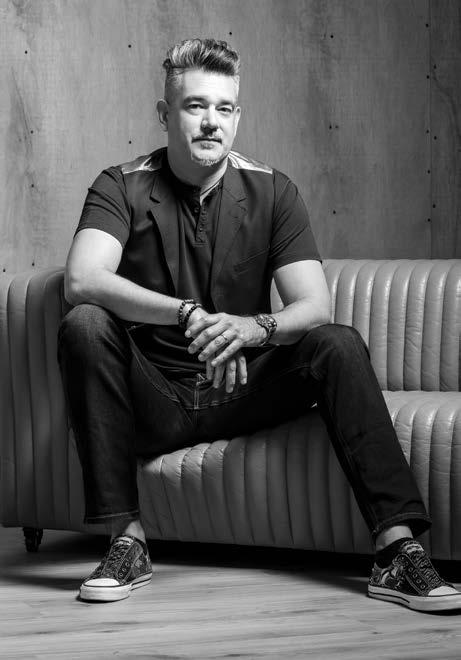
tremendous opportunity to differentiate ourselves.
Additionally, Dubai’s position as a global luxury destination created the ideal environment for this venture. The city attracts a sophisticated international audience that appreciates branded living concepts that have proven successful in markets like London, New York, and Singapore.”
The decision to partner with The Chedi emerged from a shared philosophy: “Their reputation for delivering refined, elegant experiences aligned perfectly with what we envisioned,” Kalwani says. “This partnership is about creating homes that are holistic environments— where tranquillity, service, and craftsmanship meet.”
He goes on to say; “When I describe The Chedi Private Residences as a “bold step forward,” I’m referring to multiple dimensions of this venture that represent significant advancement for Al Seeb Properties.
First, it marks our strategic elevation into the ultra-luxury segment—a considerable leap from our previous developments. This requires meeting exceptionally high standards across design, materials, construction quality, and service integration.
Second, the branded residences model itself represents a sophisticated approach to development, requiring seamless coordination between property development and hospitality operations. This integration demands a level of organizational complexity we’ve embraced as part of our evolution.
Third, the scale and
prominence of this project significantly raises our profile in the market. We’re no longer just developing properties but creating a landmark that contributes to Dubai’s iconic skyline and global reputation.
Finally, the financial commitment required for a development of this caliber demonstrates our confidence in both our vision and Dubai’s continued growth trajectory. It’s a statement of our ambition and long-term perspective on the market.”
According to Kalwani, the team has been deliberate in aligning timelines and construction standards with the brand’s ethos. “The first phase is expected by Q1 2029, with full completion shortly after. We’ve accounted for contingency, because we’re not compromising quality for speed.”
More than infrastructure, he emphasizes intent: “It’s not about building more. It’s about building better— spaces that reflect a philosophy of life, not just an address.”
“We didn’t want to just follow the branded residence trend,” Kalwani adds. “We wanted to elevate it—to create something so distinct in quality and service that it becomes the gold standard in the region. That’s our ambition with The Chedi Private Residences.”
Kalwani also stresses the financial and operational prudence behind the project. “We’re self-funding this development. That gives us control, flexibility, and assurance that quality won’t be compromised by external pressures.
Transparency is key in today’s market.”
“In Dubai’s competitive landscape, The Chedi Private Residences distinguishes itself through several key differentiators. First, our partnership with The Chedi brings a hospitality pedigree that few branded residences in the market can match. Their distinctive approach to service—unobtrusive yet anticipatory—creates an atmosphere of refined comfort rather than ostentatious luxury.
Second, we’ve taken a deliberately different approach to design. While many luxury developments in Dubai emphasize visual spectacle, we’ve focused on creating living spaces that balance aesthetics with genuine liveability. Our residences feature thoughtful spatial planning, superior acoustic engineering, and climate-responsive design elements that enhance daily living.
Third, we’ve implemented a strict density control philosophy, limiting the number of residences to ensure exclusivity and allow for more generous private spaces. This approach contrasts with the market trend toward maximizing unit count and creates a more intimate residential community.”
Furthermore, Kalwani adds “The success of The Chedi Private Residences will serve as a foundation for expanding our branded residence collaborations, potentially bringing other distinguished hospitality brands into residential partnerships. However, we’ll maintain selectivity in these relationships, ensuring each brand partnership offers a truly differentiated living experience.
Beyond branded residences,
we aim to pioneer new residential concepts that anticipate evolving lifestyle preferences. This includes exploring communities built around specific wellness philosophies, creative districts that integrate living and working spaces for the cultural sector, and multigenerational developments that accommodate changing family dynamics.”
Bruno Guélaff speaks of the project as both a professional milestone and a personal passion. “The Chedi Private Residences is an architectural statement, but more than that, it’s a spiritual experience,” he says. “We wanted each residence to evoke emotion, serenity, and belonging.”
Guélaff’s firm, BG Group, was born from a friendship and shared vision with co-founder Khalid Kaluti.
“Our shared dream was to build a design + build studio where trust, transparency, and excellence guide everything,” he says. Their expertise ranges from MEP and interiors to kitchens and automation, giving them full control over detail and delivery.
He calls The Chedi Private Residences a natural evolution: “We brought villa-style living into a tower, and that’s no easy feat. Expansive layouts, 3.2-meter ceilings, deep terraces—it’s all about breathing space.”
All the details from exterior architecture to the interior design have been fully designed, crafted and curated by Bruno Guélaff’s studio.
Guélaff highlights the
Stephan Schupbach has decades of experience leading world renowned luxury properties



OUR MISSION HAS ALWAYS BEEN TO CREATE PLACES THAT MOVE PEOPLE - NOT THROUGH EXTRAVAGANCE, BUT THROUGH MEANING,” STEPHAN SCHUPBACH EXPLAINS. “AT THE CHEDI PRIVATE RESIDENCES, WE’VE TRANSLATED OUR HOSPITALITY DNA INTO A PERMANENT, RESIDENTIAL EXPERIENCE”
triplex penthouse as a personal favorite: “It has plunge pools, sweeping views—it’s a true expression of what it means to live exceptionally.”
But even the smallest units are crafted with the same rigor. “We deliberately broke away from cookie-cutter layouts. In this market, so much feels mass-produced. This project is our counterpoint.”
His hands-on involvement is well known. “From concept sketches to material selection, I was there. That’s what it takes to maintain creative integrity across 52 floors.”
He also emphasizes the project’s lifestyle narrative: “We didn’t just add amenities—we curated them. From lagoon pools to private padel courts, everything is intentional.
It’s a complete world in itself.”
“In every aspect—from the stone selected to the lighting schemes—we wanted to create timelessness,” he explains. “This is not a trendy project. It’s a legacy building.”
Stephan Schupbach, CEO of Chedi Hospitality speaks from decades of experience leading some of the world’s most elegant properties.
“Our mission has always been to create places that move people—not through extravagance, but through meaning,” he explains. “At The Chedi Private Residences, we’ve translated our hospitality DNA into a permanent, residential experience.”
Schupbach emphasizes
cultural authenticity, emotional connection, and aesthetic harmony as pillars of the Chedi brand. “Luxury here is not about opulence. It’s about resonance. The smallest design touch, the flow of space, the softness of service—these are the things people remember.”
When asked about the unique Chedi imprint on the project, Schupbach is clear: “The service is intuitive, the architecture is serene, the wellness integration is real. Everything is geared toward a life lived in balance.”
One of his favorite features? “The flow between private sanctuaries and communal wellness areas. It’s seamless. It encourages mindfulness in daily life. That, to me, is the new luxury.”
The collaboration with Al Seeb Properties has been a high point: “We’re very selective with partners. Al Seeb brings depth, vision, and respect for long-term value. This is not just a project—it’s a shared journey.”
“Residences should have a soul,” Schupbach insists. “And that soul comes from a hospitality ethos that prioritizes people above all else.”
Mark Burns, with over 35 years in hospitality design, calls this project a careerdefining moment. “It’s rare to find a team where brand, developer, architect and interior designer are so aligned. That synergy is what elevates the outcome.” Burns has worked on
icons from Claridge’s to Eden Rock, and now oversees Chedi’s global design direction. “This is our first branded residence project, and we wanted to get it right,” he says. “It’s a vertical resort, yes—but it’s also deeply residential.”
One of the key design principles was separation of flow: “We created discreet zones for residents and service support. That’s something drawn from palace living. It maintains both privacy and efficiency.”
His approach to sustainability is thoughtful, not flashy. “It’s integrated in how we source, how we plan, how we power. True sustainability doesn’t scream—it simply works.”
He adds: “Every detail matters. It’s about elevating every touchpoint of daily life.”
“The lighting, sound, and material
development, brand, and design—a singular vision emerges. The Chedi Private Residences is not simply a tower. It is a manifesto.
Kalwani sees it as a new value proposition: “True luxury is about anticipation. Anticipating what residents want, how they want to live, and how that evolves over time.”
Guélaff describes it as a commitment to human-centric design: “It’s not just what a space looks like—it’s how it feels. That’s what defines legacy architecture.”
Schupbach reflects on the emotional payoff: “We are creating homes that hold memory, that foster belonging. This is hospitality as lifestyle.”
Burns closes the loop: “Design is about storytelling. And this story is written with purpose, grace, and restraint.”
launches of the decade.
All four leaders are united in their optimism.
Kalwani sees Al Seeb evolving into a boutique luxury developer, focused on wellness-forward and sustainable projects across the UAE. “We’re not expanding fast—we’re expanding smart.”
Guélaff envisions continued innovation through design. “This is just the beginning of our branded residence journey. We have more stories to tell.”
Schupbach talks about redefining luxury. “Chedi is a philosophy. Wherever we go, we’ll bring this ethos with us. Thoughtful, grounded, and enduring.”
Burns, ever the pragmatist, speaks to legacy: “We design for

palette all transcend the Chedi ethos to enhance not just how the space looks—but how it makes you feel,” Burns says. “This is luxury that lingers.”
Across every discipline—architecture,
As Dubai continues to ascend on the global stage, The Chedi Private Residences sets a new benchmark for what it means to live—and live well—in the city of the future. With completion expected in 2029 and a strong sales pipeline already in place, the development is positioned as one of the most anticipated
longevity. Our goal is not to impress the market. It’s to impact people. If we’ve done that, we’ve succeeded.”
The Chedi Private Residences exemplifies a new standard in luxury living, balancing curated partnerships with a commitment to creating homes designed for lasting value and timeless appeal.
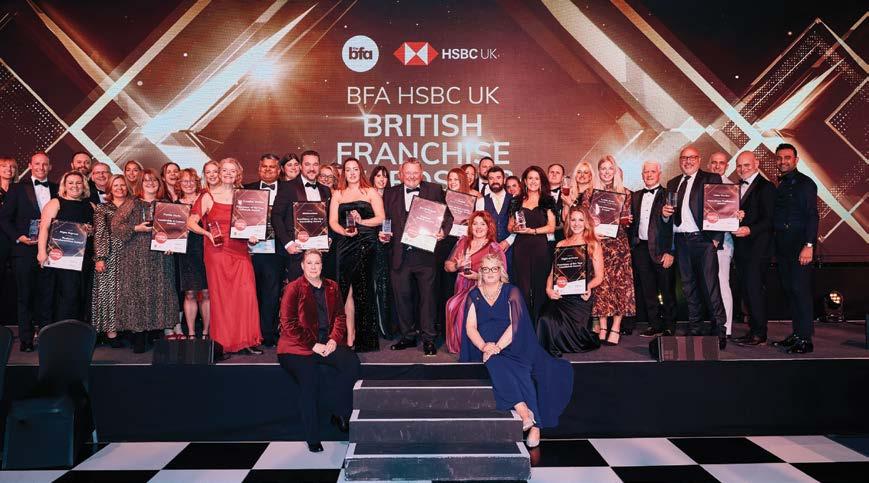
Are awards old hat or are they more important now than ever? The BFA (British Franchise Association) awards can form a crucial part of a prospective franchisee’s search for the right investment opportunity and have transformative effects on brand awareness and credibility for the winners. As the UK’s self-regulatory body for franchising, The BFA have been supporting businesses to ‘discover their tomorrow’ through business format franchising since 1977. A standards-based membership organisation, we have over 330 franchisor and 1,800 franchisee
members, all committed to practising ethical franchising and my fellow judges and I are working hard, judging entries for the 2025 BFA HSBC UK British Franchise Awards.
This year we’ve received over 130 entries with more than 75 brands involved, each hoping to win one of our 14 categories. Entrants range from individual franchisees who will be recognised for giving back to their local communities all the way up to the crème de la crème of franchising brands, vying for the top spot of ‘Franchisor of the Year (Established). Behind the scenes it takes five people ten days and
almost 300 hundred hours to select our winners, so we have our work cut out for us but reading the entries is a privilege and a job we take very seriously. But why are the BFA, or in fact any awards, so important in 2025, and are they more important now than ever before?
In an age where a brand’s success lies largely in its ability to be ‘seen’ on a phone or laptop, rightly or wrongly, a talented digital marketing team can sometimes win the digital race, leaving those with less impressive skills, but possibly with a much better product, lagging behind. So how
does winning awards address this imbalance?
Take the PR high ground
I cannot stress enough how winning an award, from a well-respected organisation, like the BFA, can help a company rise above the digital ‘noise’ and demonstrate what a great job they’re doing.
Audiences today are well versed in sniffing
out a fake from the real thing and understand that it takes more than a viral video to win a top award, so reading about your brand’s win at a well-respected awards ceremony in a magazine or newspaper, on their socials or even in their newsletter, is the kind of news that sticks, for all the right reasons. Did you know you can legitimately describe yourselves as an ‘award-winning’ company for 12 months after the event,
invaluable PR, providing you enter the right awards.
Thirty-six years of franchising excellence
Now in their 36th year (and I’ve been to 25 of them…) the BFA awards are known as the ‘Oscars’ of the franchising world and for good reason. Competition is stiff, with brands working incredibly hard to submit outstanding entries, all too conscious that a win could
see them propelled into the limelight, on a wave of PR and marketing.
Priceless brand elevation
NOW IN THEIR 36TH YEAR, THE BFA AWARDS ARE KNOWN AS THE ‘OSCARS’ OF THE FRANCHISING WORLD AND FOR GOOD REASON” }}
John Preston, managing director of Mathnasium UK, winner of ‘Franchisor of the Year – Expanding’ in 2024 explains: the real effect of winning: “Winning wasn’t just a proud milestone, it was a defining moment for our brand. It’s boosted confidence across our network, elevated our visibility and become a mark of quality we lead with in recruitment and marketing. In a crowded market, that kind of credibility is invaluable.”

IN AN AGE WHERE A BRAND’S SUCCESS LIES LARGELY IN ITS ABILITY TO BE ‘SEEN’ ON A PHONE OR LAPTOP, RIGHTLY OR WRONGLY, A TALENTED DIGITAL MARKETING TEAM CAN SOMETIMES WIN THE DIGITAL RACE, LEAVING THOSE WITH LESS IMPRESSIVE SKILLS, BUT POSSIBLY WITH A MUCH BETTER PRODUCT, LAGGING BEHIND”
In franchising, as in many areas of business, trust in the brand is everything. With franchisees investing tens of thousands of pounds when buying their new businesses, anything a franchisor can do to highlight their credibility, is particularly powerful. Lucy Campbell, CEO of Right at Home UK who walked away with what is possibly considered the top prize, Franchisor of the Year (Established) in 2024 said: “To have won this highly esteemed award was an absolute honour. It has strengthened our credibility, opened new conversations, and reinforced trust in our brand.”
Sarah Cressall OBE, founder of The Creation Station, who won the 2024 Lifestyle Brand Award describes the effect on her creative activity franchise after her win: “It boosted our credibility, opened new doors, and gave our whole network a real lift in value and recognition. It clearly evidenced our leadership in the sector and provided strong marketing positioning for us, as a trusted provider
of a supportive, professional and dynamic brand.”
A large award can also help you raise your reputation in your own industry, as Aaron Davis, network development manager at Signs Express who won the 2024 Business Transformation Award says: “The award has absolutely elevated our brand credibility – particularly within the franchising and signage industries, plus the response from our clients and network was hugely positive.”
So whatever industry you are in, whether you own a franchise brand or a fish and chip shop, are a start-up or a 50yr old business, look out for your local business awards and put yourself on the map in 2025 with a 12 month PR boost that money simply can’t buy.
Five top tips to stand out at awards (for example, the BFA Awards)
1/Read the category requirements carefully - We reject multiple submissions every year because they haven’t read the instructions properly. Don’t just shoe-horn your story in.
2/Give us data – facts and figures about your achievements. Has it pushed the dial? Tell us by how much. Prove your claims.
3/Never go over the word count – your entry will fail before it’s even begun.
4/Be there – and be brilliant. If you’re shortlisted, you’ll may be invited to a live judging session. Treat it like an interview for a dream job. Be prepared, passionate and present — literally. Missing it?
That’s game over.
5/Communicate like a pro - Awards organisers want you to do well. So, if they ask for more info or clarification, respond quickly and clearly. Don’t leave them chasing you – it doesn’t reflect well.

Pip Wilkins is the Chief Executive of the British Franchise Association (BFA), bringing over 25 years of dedicated experience in the franchising sector. Having progressed through various roles within the BFA, Pip has gained a comprehensive understanding of the broader franchise industry, earning widespread respect for her deep expertise and unwavering commitment. She lives in Devon and is an avid Chelsea FC fan.
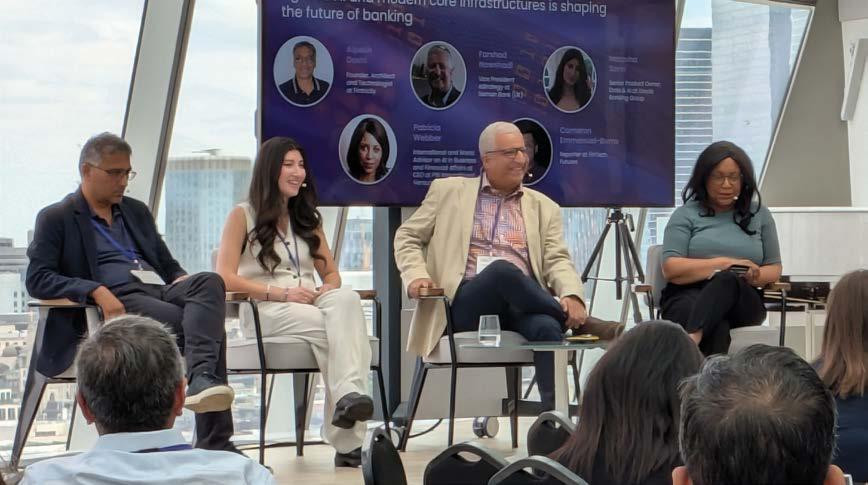
The insights Farshad Nowshadi can offer from 35 years in banking. by PATRICIA
CULLEN
Farshad Nowshadi blends experience with a sharp vision that doesn’t just keep pace with the global financial ecosystem - it’s helped shape it. With over three decades in financial services - spanning global consultancy roles at Reuters Financial Services to mentoring early unicorns such as Revolut and WISE to helping establish blu Bank, the Middle East’s leading mobile-first bank going in 4 years to also become the fifth largest mobile bank in the world with 14 million users, Nowshadi helped to foster the brilliant start-up teams that bridged the legacy systems of
traditional banking with bringing convenience, ease of use and just fun into a banking interface. Having backed Google and Amazon in their early days, he brings a rare blend of first-hand tech insight from those formative years and a sharp foresight for the future, making him a key voice on AI for start-up and VC communities in 2025. His career reflects an ability to not only spark growth but sustain it - a testament to the kind of long-term resilience and strategic thinking that financial technology demands. Nowshadi’s openness to sharing the hard-earned secrets of his success was clear from the get go. “I’ve learned invaluable lessons and strategies - now, my goal is to pass them on,” he says.

In the 1980s, while at Learning Tree International, Nowshadi was instrumental in guiding CEOs and CTOs of major banks through the early implications of the internet for all their financial services — offering a glimpse into the digital future of financial services well before the industry’s full transformation began. “There was much confusion at that time,” he recalls, drawing a parallel to today’s turbulence around AI and blockchain. “What I learnt was that a clear understanding from the beginning was paramount… a lot of people pretended, but they didn’t really understand,” he reflects - a lesson that would shape his approach to innovation and leadership in the years to come.
“
WITH THE RIGHT KNOWLEDGE, YOU’LL BE ABLE TO MAKE MORE INFORMED DECISIONS - WHETHER IT’S ABOUT WHERE TO INVEST OR HOW TO NAVIGATE KEY ENTREPRENEURIAL CHOICES. IT’S ABOUT CUTTING THROUGH THE NOISE AND IDENTIFYING WHAT REALLY MATTERS”
Likewise, as artificial intelligence continues to attract both excitement and uncertainty, Nowshadi stresses the need for clarity over clatter. For entrepreneurs, he says, that means turning to credible sources and building a thoughtful, informed perspective - not simply getting swept up in the hype. “We all talk about LLMs and AI agents, but it’s crucial to find ways to grasp these concepts in a straightforward, accessible way.” He also warns against relying on surface-level knowledge: “Don’t overwhelm yourself - take the time to analyse the topic through trusted sources and ensure you have a deep, solid
understanding.” This solid foundation, he explains, is essential: “With the right knowledge, you’ll be able to make more informed decisions - whether it’s about where to invest or how to navigate key entrepreneurial choices. It’s about cutting through the noise and identifying what really matters.”
Nowshadi’s tenure as a global consultant at Reuters Financial Services - a company built on the value of real-time, precise information - shaped his
understanding of the power of data. “As the information gets delayed, its value diminishes,” he explains. This experience cemented his belief that effective management of current data is essential for success. “Whoever controls the freshest data controls a tremendous amount of business.” He points to Google as a prime example of this in action, a company he invested in early on. “They’ve mastered the art of bringing the world’s data to us in real time, and look at the success they’ve achieved. Because, in the end, data is king.” With the rise of AI, Nowshadi offers a clear warning: “You can talk about the most advanced LLMs or AI agents, but it all boils down to the quality of the data they’re working with. In computing, there’s a term called GIGOgarbage in, garbage out. To make meaningful, high-stakes decisions, you must control your data. The more current and accurate it is, the more valuable it becomes.”
Lesson three: Customer obsession is a nonnegotiable
One of the most defining moments of Nowshadi’s career came during his time working with the “Greenhouse Fund,” an incubator within Voices Financial Services, where he had a front-row seat to Amazon’s evolving

“
OFFER BETTER SERVICE, MORE CONVENIENCE, AND LOWER COSTS
culture. He and his team would quietly listen in on customer calls to understand how companies were truly interacting with their customers.
What struck him most about Amazon was their unwavering commitment to customer satisfaction: “They were
100% focused on the customer. If there was any doubt, they’d refund your money or return your goods - no questions asked. And they pioneered that one-click checkout.” He puts it simply: “It’s all about customer satisfaction, isn’t it?”
For entrepreneurs, Nowshadi stresses that prioritising customer experience is the foundation of lasting impact: “The most successful entrepreneurs are the ones who laser-focus on customer satisfaction. These are the core principles that will shape future success.”
Lesson four: Seek unbiased feedback - don’t rely on friends and family
Nowshadi’s stint on MasterChef in 2016 provided him with a surprising yet valuable lesson in entrepreneurship. “I’d cook all these dishes and ask my friends and family what they thought. Of course, they were totally biased - ‘Oh, Farshad, this is great, they’d say.’ But the real insight came when a judge pointed out the inconsistent flavours in a dish - something Nowshadi hadn’t noticed.
The takeaway? “As an entrepreneur,
you have to ensure the feedback you’re getting is genuine and impartial, not sugarcoated. Don’t ask your friends and family. Don’t seek validation from those who are emotionally invested. They’ll tell you how clever you are, but that’s not real feedback.”
Lesson five: Know when to quit Entrepreneurship isn’t just about starting up. Sometimes, it’s about shutting down. Nowshadi reflects on an experience from his time in Iran, where, between 2005 and 2010, he launched an early Amazon-style platform called BazIran (The Bazaar of Iran) , attracting 100,000 users. “It didn’t work, inetrnet service was poor, expensive and people just were not prepared to pay online in those days and only wanted Cash on Delivery. The market wasn’t ready,” he admits. Despite the struggles, he hesitated to close the venture, allowing it to drag on until the situation worsened. His takeaway?
“Sometimes, businesses aren’t working. You have to recognise it and shut them down. That’s a critical skill - knowing when to pivot or walk away.”
SOMETIMES, BUSINESSES AREN’T WORKING. YOU HAVE TO RECOGNISE IT AND SHUT THEM DOWN.
THAT’S A CRITICAL SKILL - KNOWING WHEN TO PIVOT OR WALK AWAY”
For Nowshadi, this ability to step back is as vital as the art of building a start-up itself. “One of the classic things I always say is: if you want to build the most beautiful house, build it, then knock it down and build it again. You learn so much through that process.”Highlighting a cultural divide, he says, “In America, people respect those who fail and come back stronger. In Europe, however, failure is often overlooked or dismissed. But I believe failure is a crucial part of learning and growth.” Through this, he hopes to emphasise the value of recognising when something isn’t working.
Beyond the lessons:
While the lessons above serve as a blueprint for any entrepreneur, Nowshadi’s story is far from onedimensional. He brings a wealth of experience from mentoring early unicorns like Revolut and WISE, as well as from his hands-on work with blu Bank. His understanding of both traditional banking and cutting-edge
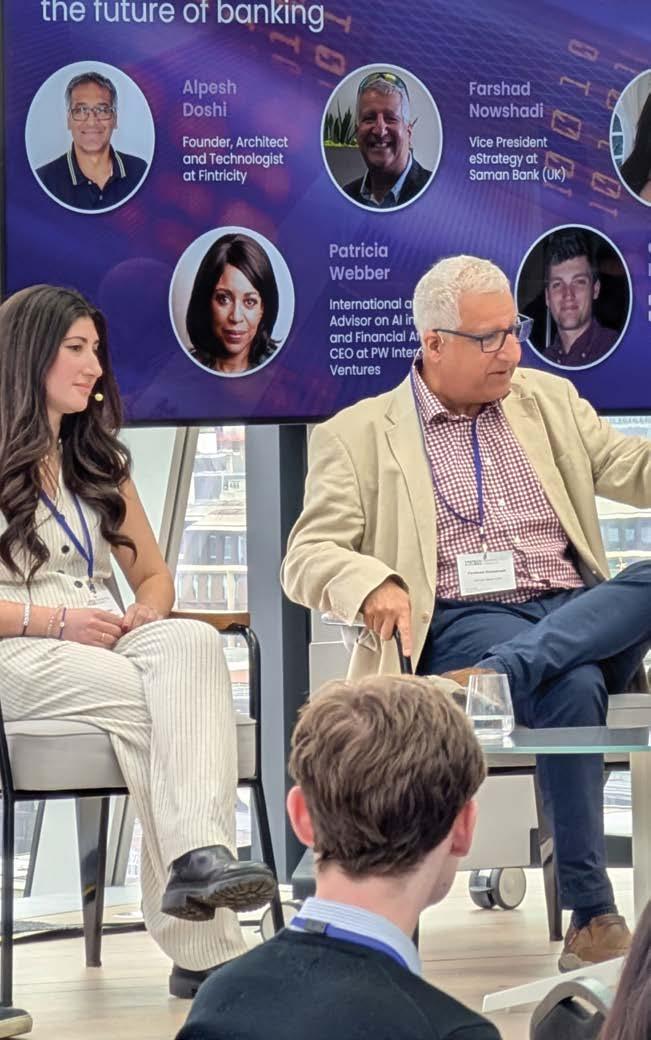

fintech allows him to bridge worlds, bringing an innovative mindset to every venture he touches.
Mentoring:
“I loved mentoring early unicorns like Revolut and WISE,” says Nowshadi. He recalls meeting Revolut founder Nikolay Storonsky in 2014. “I came across this cheeky chap called Nikolay. I remember thinking, wow, this guy’s ambitious.” What stood out most was Storonsky’s personal financial commitment: “He was ready to invest a significant amount, think it was around £100,000 of his own money. I admire that - someone who backs their ideas with their own funds.”
Nowshadi admits his traditional banking background made him cautious: “It takes 30 years to build a reputation, but only five minutes to lose it.” While regulatory challenges remain for Revolut, he praises their growth. Similarly, he lauds WISE founders Taavet Hinrikus and Kristo Käärman, who revolutionised currency exchange. “They were fed up with the fees banks charge. The idea of a peer-to-peer
platform charging a fraction of a percent was brilliant.” Today, he notes, “Look at them - they’re number one.”
Nowshadi recalls that during the early establishing phase of blu Mobile Bank, to overcome early credibility challenges and ensure efficiencies, it was a pivotal decision to ensure blu Bank partnered with a larger bank for regulatory support while building the software and customer experience from the ground up. He contrasts the efficiency of the Mobile -bank model with traditional banking: “A traditional bank might serve four or five million customers with 11,000 employees. At blu Bank, we have 14m customers with just a few hundred workers.” Operating without physical branches, blu Bank excels in usability and its executive focus on true customer convenience. Reflecting on the limitations of legacy infrastructure, Nowshadi adds, “The next generation of banks, which often will be around DeFi
concepts, will need to start with a clean slate, not rely on legacy banking inefficient systems.”
He concludes, “Don’t reinvent the wheeloffer better service, more convenience, and lower costs for customers.”
or become redundant
Looking ahead, Nowshadi views AI as an undeniable disruptive force.
“There’s a tsunami of change coming. It’s not just a toolwhether you’re a florist, a writer, or a businessperson - AI will touch every corner of life.” He warns, “The real question is: Will you harness this technology for your benefit, or will you become redundant?” Looking ahead, he predicts that AI agents will soon take on senior rolespotentially managing entire businesses with minimal human involvement - acting as department heads with clear strategies and dedicated resources. Optimistic about AI’s potential to democratise expertise globally, Nowshadi highlights the opportunities across the medical field: “Anyone, anywhere - whether in rural India or
Afghanistan - could potentially access top-tier medical advice by uploading their images and getting the best consultants.” Yet, he raises concerns about oversight: “Who will these AI agents be accountable to? I don’t think the answer can be regional, it must be an international standard, possibly overseen by organisations like the United Nations.”
A vision for a global future
Nowshadi envisions a future where governance transcends borders, with global standards replacing traditional systems. “I believe in universal suffrage and a world more like the United Nations,” he says. He foresees AI agents replacing governments, creating a future of abundance and fairness.
Drawing from his vast experience in banking and fintech, Nowshadi’s parting advice to entrepreneurs: “Understand deeply, focus on customers, embrace real-time data, seek honest feedback, and know when to pivot. The future is fast - don’t wait until it’s too late.”
Growth
Inside the growing pains - and gains - of a UK start-up choosing substance over speed by ENTREPRENEUR UK
STAFF
Over half way into 2025, clarity is coming into focus for many start-up founders - not just on what’s working, but on what no longer serves. For Nnamdi Emelifeonwu, CEO and co-founder of Definely, the legaltech start-up simplifying how professionals
work with complex documents, this year has marked a shift in how the company operates, grows, and leads. Definely has seen strong traction in the legal sector, but beneath the product milestones and momentum lies another transformationone that Emelifeonwu says has been key to operating at scale.
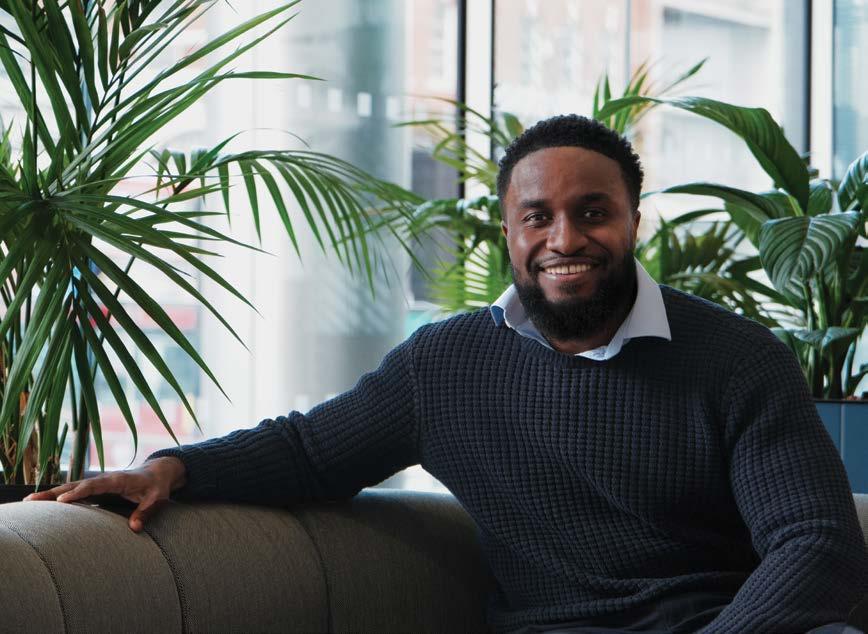
Nnamdi Emelifeonwu, CEO and co founder of Definely
Hiring a Head of People has been a game-changer,” he says. “As we scale, I can say with certainty: we wouldn’t be functioning at this level without someone fully dedicated to building and maintaining the culture, systems, and processes that hold everything together.” That’s a sharp contrast to how things looked just a year ago. “We were still able to communicate informally, solve people challenges reactively, and rely on founder intuition. That stops working once you hit a certain size.” Now, with a formal people function in place, Definely is “more structured, more intentional, and better aligned - and it’s made a huge difference to our momentum.” In other words, culture and systems aren’t nice-to-haves - they’re infrastructure.
Cutting through the noise
Focus has been another key evolution in 2025. Like many early-stage start-ups, Definely once cast a wide net - entertaining tentative partnerships, hopeful synergies, and vague long-term plays. But that’s changed. “We used to entertain a lot of exploratory chats. Now we qualify these rigorously. If the partnership doesn’t map directly to our strategic objectives or product distribution, we politely pass.” This is not about being closed off - it’s about being clear, Emelifeonwu adds. “It’s made us faster, leaner, more focused, and ironically, more in demand.” In a year where attention is finite and pressure to deliver is high, efficiency is emerging as the real differentiator.
Leading by letting go
Founders often feel pressure to be the expert - the decision-maker, the problem-solver, the one with the answers. Emelifeonwu admits he used to buy into that mindset, but 2025 has shifted his perspective. “I used to think my job was to be the
expert in the room. I’ve realised it’s the opposite - my job is to ask the best questions, recruit people better than me in every function, and make space for them to lead.” That kind of leadership - rooted in humility rather than control - has become increasingly important as teams grow and complexity rises. It’s also an invitation to other founders: being the best doesn’t mean knowing everything; it means building the environment where others can.
The underrated edge of UK start-ups
Beyond Definely, Emelifeonwu sees something bigger unfolding - par-
“
WE USED TO ENTERTAIN A LOT OF EXPLORATORY CHATS. NOW WE QUALIFY THESE RIGOROUSLY. IF THE PARTNERSHIP DOESN’T MAP DIRECTLY TO OUR STRATEGIC OBJECTIVES OR PRODUCT DISTRIBUTION, WE POLITELY PASS”
ticularly within the UK start-up landscape, and he believes British founders may have an unexpected advantage “We’re underestimatedand that’s a secret weapon.” He continues: “UK founders build capital-efficient businesses out of necessity. We’ve operated with tighter budgets, less hype, and more scrutiny. That forces focus, resilience and product obsession. When the market shifts to valuing substance over noise - we’re already there.” In a climate where funding is harder to come by and hype cycles are flattening, that efficiency-first DNA might prove more valuable than ever.
Building what comes next
As for what comes next - not just for Definely, but for the ecosystem - Emelifeonwu is optimistic. “A UK start-up ecosystem where global category leaders don’t need to leave London to scale. More repeat founders, more operator-turnedangels, and more deep tech.” But alongside the structural changes, he’s also hoping for a change in mindset. “I’d like to see a cultural shift that celebrates ambition without self-deprecation, and of course, more opportunities for diverse founders within the start-up ecosystem.” That move toward greater confidence, greater diversity, and greater belief in what’s possible from the UK - is already underway. But Emelifeonwu knows belief is the final piece of the puzzle: “The infrastructure’s catching up - now we just need to believe it.” At this point in the year, Emelifeonwu isn’t talking about explosive pivots or chasing trends. What’s working for Definely is sharper focus, deeper trust, and smarter hiring. It might fly under the radar, but it’s exactly what drives real progress. In a time when many founders are recalibrating, his advice carries weight: focus on substance, invest in people, and don’t be afraid to ask better questions. The answers - and the scale - will follow.
by BRANDON REYNOLDS
The climate crisis is now impossible to ignore. Due to this, there is a flaring intersection between tech and climate activism coming into existence, as rapid advancements in technology meet the desperate need for widescale environmental activism. This space, which combines the rapid scaling and innovation of start-ups with the urgency of environmental action, is becoming fertile ground for ambitious tech entrepreneurs. As the Founder of Activ8, I wanted to create a platform that empowers everyday people to take part in climate activism across its many forms. Whether it is getting involved with local activities or attending peaceful protests, or even something as simple as signing petitions at home. This is all towards the goal of building a nationwide community of activists pushing positive impact, rewarding those who drive the sustainable change in local communities and collectively help hit key climate goals.Climate solutions are no longer confined to charities, corporations, and governments. There is a growing industry marrying tech and e-services with climate-positive movements. Tapping into this space requires more than just good intentions; it requires real, utilisable tools which can aid those who want to take real actions to better the climate. Here’s how tech entrepreneurs can thoughtfully enter this emerging market, and create tools that genuinely empower communities, drive measurable environmental impact, and build sustainable businesses along the way.

Many entrepreneurs still think of climate change as a sector limited to energy, carbon credits, or hardware-intensive clean tech. In reality, we’re witnessing a proliferation of digitalfirst opportunities at the intersection of activism, sustainability, and

community engagement. These include data platforms which empower communities to monitor air, water, or biodiversity metrics; apps which help citizens track environmental pledges or hold corporations accountable; and tools which facilitate transparent funding for grassroots projects. These digital products lower the barrier to entry for everyday people to become activists and help to turn awareness into action. They also open avenues for recurring revenue models through premium analytics, certification layers, or impact reporting. This is where tech
entrepreneurs with expertise in product design, user engagement, and scalable infrastructure can make a profound difference.
The most impactful climate tech platforms aren’t created in a vacuum, but are those which are built in close collaboration with local activists, scientists, educators, and underrepresented communities who are on the front lines of climate change, and suffer its most devastating consequences. I’m a beVisioneers Fellow and this community is
made up of innovators who embed themselves within the communities they aim to serve. Take Max Lehmann, for instance, who developed an app that facilitates the circular economy by enabling people to rent and lease technology. Then there are entrepreneurs like Praneetha Monipi who is developing an app that can help people proactively address wildlife trade and be part of the solution to regulate organised wildlife crime in India. Both engage with the communities who are impacted the most by environmental devastation. All of these “ecopreneurs” prioritise participatory design over top-down
AS AN ENTREPRENEUR, IT IS BEST TO DESIGN YOUR PRODUCT AROUND MICRO-ACTIONS THAT COMPOUND INTO BIGGER IMPACTS. USE NUDGES, GAMIFICATION, AND SOCIAL FEATURES TO BUILD HABITS, NOT JUST FORCE ONE-OFF ENGAGEMENTS”

solutions. For a tech entrepreneur, this means co-creating features by running workshops or pilot programs with local stakeholders, ensuring your product roadmap is shaped by people experiencing the problems first-hand, and creating transparent feedback loops so users can see how their input drives tangible change. Ultimately, the goal is to avoid “parachute tech”, solutions imposed by outsiders that fail to gain traction because they don’t align with local needs or cultural contexts.
Climate action is often abstract. People know they should “care about the planet,” but without direct pathways to act, their motivation can fizzle out. The best digital tools in this space turn broad concern into specific, repeatable behaviours that drive change. The best community platforms track personal or neighbourhood climate-positive footprints often pair metrics with actionable next steps, like challenges or group pledges. As an entrepreneur, it is best to design your product around micro-actions that compound into bigger impacts. Use nudges, gamification, and social features to build habits, not just force one-off engagements.
Too many well-meaning climate tech initiatives fail because their financial model is at odds with their mission. For example, ad-driven models can incentivise doomscrolling and the abuse of users into profit-making over meaningful action and actual change. Consider alternatives like offering subscription tiers for schools, NGOs, or municipalities in need of such tools, or certification or verification layers that organisations pay for to demonstrate climate compliance. When monetisation directly supports climate-positive
These new tech ecopreneurs can help steer humanity toward a more sustainable trajectory, proof that profit and the planet need not always be at odds” “
outcomes, it strengthens both trust and long-term viability.
5/Prioritise Transparency and Credibility
Climate misinformation is rampant. Whether it is greenwashing by corporations or confusion over carbon accounting, activists and consumers alike are now hyper-wary of misleading claims, and face fatigue at endless doom and gloom headlines. Build credibility from the start by using open data where possible, or partnering with recognised and well-trusted environmental bodies for verification. Publishing clear methodologies on how impact is calculated and not making outsized claims can also help, as will making it easy for users to trace the flows of money within your climate-positive venture. This is especially important if your platform helps mobilise funds or measure climate impact, as users need to trust that their contributions translate into real-world results.
6/Leverage the Power of Network Effects
Climate activism is inherently communal. Movements thrive when people see their peers participating, whether through social sharing, leaderboards, or community milestones. Design your platform to amplify these network effects. Enable local groups to create chapters or event hubs. Highlight
collective metrics, e.g.: “Your city reduced waste by X tons this month.” Encourage friendly competitions between schools, companies, or neighbourhoods to increase uptake. This taps into social dynamics that drive sustained engagement and spreads your tool organically, reducing costly marketing spend.
The convergence of climate activism and digital entrepreneurship is just beginning. It is a movement propelled by a generation which has grown up with the internet, and one that expects to tackle the climate crisis not only through voting and protesting but by embedding impact into daily life, a daily life which is often mediated by technology. These new tech ecopreneurs can help steer humanity toward a more sustainable trajectory, proof that profit and the planet need not always be at odds.
Brandon Reynolds is the founder of Activ8 and beVisioneers fellow. His new social app, “Activ8”, is designed to make environmental activism available to all, on a local and national level. The beVisioneers: The Mercedes-Benz Fellowship winner aims to simplify environmental activism by offering tailored opportunities for political, economic, educational, legislative, and local engagement. Partnered with Friends of the Earth, he aims to turn a generation into climate changemakers.
The future of the job market will be defined by skills, not by where you went to university. by
ARIEL RENOUS

While UK universities are busy counting record tuition fees, the corporate world is quietly dismantling one of modern business’ most expensive untruths: that a degree equals competence. UK job vacancies have plummeted to four-year lows, yet graduates are flooding the market with degrees that businesses view as irrelevant. Meanwhile, British universities, once global powerhouses, are haemorrhaging their rankings while charging students more than ever for the privilege of learning yesterday’s skills for tomorrow’s corporate needs. And this is an illustration of a global pattern: Harvard Business School’s post-MBA employment rate has plummeted from 90% in 2023 to 77% in 2025, proving even elite institutions aren’t immune.
Graduates are starting to question the social contract they were sold: work hard, get good grades, earn a degree, and prosperity will follow. But the contract forgot to mention in the fine print that keeping skills relevant to what employers actually want would become their responsibility, not their educator’s. What was once a golden ticket to economic freedom has become an
“
What was once a golden ticket to economic freedom has become an increasingly expensive credential that offers little guarantee of success in the modern workplace. MBA programs are producing theoretical experts, while businesses desperately seek individuals who can actually solve realworld problems”
increasingly expensive credential that offers little guarantee of success in the modern workplace. MBA programs are producing theoretical experts, while businesses desperately seek individuals who can actually solve real-world problems. Companies are
increasingly hiring based on demonstrable skills rather than academic pedigree, leaving degreeholders wondering why their expensive education didn’t prepare them for what employers actually want. Even those who’ve reached the top are questioning this logic; Bill Winters, CEO of Standard Chartered, recently called his Wharton MBA “a waste of time”.
The evidence is mounting everywhere. 90% of HR leaders are
founders to hire them on day zero and worked as Chief of Staff for a CEO who raised $6.5m. When we needed someone to help with our launch, we didn’t look for someone with an MBA; we chose someone who’d been solving real problems for years.
The stories of entrepreneurs who chose alternative paths aren’t new. Richard Branson and Howard Schultz have been household names for years. What’s changed is how we see their path to success. These were once

looking to hire outside of traditional degrees as they prioritise skills. The smart entrepreneurs I know aren’t waiting around to see how this plays out. At Augment, we’ve seen this firsthand. Our Head of Product never attended higher education, but began building websites for major brands like Evian and Jaguar at the age of 15. By the time most people graduate, they’d already convinced startup
framed as extraordinary exceptions who succeeded against the odds by forgoing traditional higher education. Now they’re looking like pioneers who simply got there first.
This shift is accelerating as entrepreneurial people recognise a simple truth: skills can be acquired without shouldering degree debt or paying the premium for academic validation. The corporate world is
already demonstrating this shift with its hiring policies. Google, IBM, and Apple have all quietly dropped degree requirements, not out of good faith, but because they’re reading the room and looking to the future. With LinkedIn projecting that 70% of job skills will fundamentally change by 2030, the writing is on the wall. Technological skills are projected to grow in importance more rapidly than any other skills in the next five years, with AI and big data at the top of the list, followed by networks, cybersecurity, and technological literacy. Creative thinking, resilience, flexibility, and agility are also gaining importance, alongside curiosity and a commitment to lifelong learning. Smart employers are betting on these adaptable, forwardthinking capabilities over academic credentials that may be irrelevant before the degree loan is paid off.
For employers, this isn’t about choice; it’s about survival. While others fight over the same pool of credentialed talent, forward-thinking companies will be assembling teams that think differently, cost less, and execute faster. Beyond the AI job headlines lies a bigger picture. Marc Andreessen famously declared that software was ‘eating the world’ back in 2011. Just over a decade later, AI has devoured software itself, and now it’s eyeing degrees for dessert. The four-year degree you

Google, IBM, and Apple have all quietly dropped degree requirements, not out of good faith, but because they’re reading the room and looking to the future” “
start today could be teaching you to operate systems that won’t exist when you graduate, while the person learning skills in real-time is already winning.
“But it’s about the people you meet at business
school,” goes an old adage. This advice worked when geography and gatekeepers controlled access, and while university networks connect you to people who happened to attend the same institution, Twitter
(X) connects you directly to industry leaders, LinkedIn opens doors to opportunities around the world, and Discord unites practitioners solving real problems in real time. The entrepreneurs in my network are not learning from professors and coursemates who’ve never been in business. Instead, they’re getting strategy tips from those who’ve scaled startups to millions in revenue, learning from investors who write the checks, and connecting with engineers who’ve debugged code at 3am before product launches. These connections are built around skills and real-world experience. While students bond over shared struggles with deadlines, skills-first learners are building relationships with people who are actually shaping their industries. Paying $50,000+ to learn yesterday’s skills for the sake of meeting people who are also learning yesterday’s skills is collective obsolescence with a hefty price tag. We’re witnessing the end of an era where credentials mattered more than competence. The smart money isn’t debating when or whether this shift will happen; it’s positioning to profit from it. While others cling to yesterday’s talent strategies, the future belongs to those who acknowledge that in a world moving this fast, learning never graduates.
Ariel Renous is the co-founder and CEO of Augment
Despite calls for a return to the office, the truth is many workplaces were failing long before the pandemic - and clinging to nostalgia won’t fix what was already broken.
by DOMINIC DUGAN
There’s a lot of noise right now about hybrid work hurting productivity and office culture. Some feel that having people in the office less often is creating real challenges - and in response, there’s a growing push for more regular office attendance. But what if the ‘golden age’ they’re longing for never really existed at all? At Oktra, our data shows that even before the pandemic, more than 40% of desks sat empty on an average day. Offices weren’t the thriving hubs many now romanticise. They were often uninspiring, underused, and poorly suited to how people actually work. The pandemic exposed that reality, and now, there’s an exciting opportunity to rebuild something better. But it starts with letting go of old assumptions and asking the harder, more important questions: What do people really need from the office today? And are we designing spaces that earn their place in modern working life?
The reality is, long before 2020, many people had already found ways to work that suited them better: meeting rooms, coffee shops, or even at a client’s office. The traditional office was already under strain - underused, uninspiring, and poorly aligned with evolving ways of working, and not many bosses were asking why. People were in because they were contracted to be, not because it was the best place to get things done. And even then, many weren’t truly in. We would see ‘signs of life’: bags on chairs or coffee cups on desks while they found alternative, more suitable places to work. Now we’re seeing major firms, including Morrisons and Dell, mandating five days in the office for staff. The uncomfortable truth that nobody is talking about is that many of these businesses are forcing employees back to offices that were never truly fit for

purpose. Many retain fundamental issues like inadequate meeting spaces, clunky technology, cramped environments, and designs that simply don’t support how people actually work. This situation results in staff retention problems, diminished client experiences, and the very productivity problems these mandates were supposed to solve. When you force staff into unsuitable environments, engagement isn’t necessarily the result. In fact, you often get disengagement, conflict, and quiet exits - weeks after enforcing a return-tooffice mandate.
Fast forward to today, and businesses are investing heavily in making offices more visually appealing. I’ve seen design briefs fixate on details - from plant walls to high-end furniturewithout once mentioning how teams actually use the space. But design isn’t just about how a workplace looks. It’s about how it performs. Aesthetics can’t compensate for friction. If your team can’t find a quiet space to focus, or if the tech fails every third meeting, no amount of premium finishes will make people want to come in. When a workspace works - really works - people don’t just get more done. The The part we often overlook is that functionality isn’t just about productivity. It’s foundational to culture. When people feel supported by their environment, they collaborate more openly, stay longer, and identify more deeply with the business. A high-performing space leads to high-performing teams. But even the best-designed workplace can fall flat if people don’t understand how to use it. That’s why successful environments aren’t just built for people - they’re built with them. Involving users in the design process leads to smarter decisions, better utilisation, and ultimately, spaces people feel connected to and confident in.
We’ve reached a crossroads. Leaders can either double down on nostalgia, or take this moment to rethink what the office is actually for - and how it needs to perform. After two decades designing workspaces for some of the biggest brands in the world, including Deliveroo and YouTube, here’s what I’ve learned:
1/Test before you mandate: Don’t rush to reinstate rigid office policies without asking: Can our space actually support the way people work today? Many don’t. Before declaring a four- or five-day RTO policy, pilot it. Watch how the space performs. Where do people gather? What’s always booked? What goes unused? A mandate without testing is just a shortcut to the same problems that broke the office in the first place.
2/Function over fashion: The opportunity now isn’t just to redesign how offices look. It’s to rethink how they work. Stop investing in beautiful but dysfunctional spaces. Instead, create environments that genuinely support different types of work.
THE PART WE OFTEN OVERLOOK IS THAT FUNCTIONALITY ISN’T JUST ABOUT PRODUCTIVITY. IT’S FOUNDATIONAL TO CULTURE. WHEN PEOPLE FEEL SUPPORTED BY THEIR ENVIRONMENT, THEY COLLABORATE MORE OPENLY, STAY LONGER, AND IDENTIFY MORE DEEPLY WITH THE BUSINESS”
This means providing variety: quiet zones for concentration, collaborative areas for high-energy work, and private spaces for focussed tasks.
3/Know the true capacity and limitations of your space: Before you ask more of your environment, assess what it’s capable of. Is there enough variety? Are tech and acoustics enabling good work - or quietly sabotaging it? Brightmine research shows that 15% of UK firms have already increased mandatory office days. But if your environment isn’t equipped for higher occupancy, all you’re doing is accelerating friction, disengagement, and turnover.
The return to the office doesn’t have to be a repeat of the past. It can be a turning point. A chance to create flexible, functional spaces that genuinely support people in doing their best work, whether they’re based in the office full-time, hybrid, or primarily remote. The firms that will succeed aren’t those trying to recreate a mythical golden age of office culture. They’re the ones recognising that the future belongs to workspaces that earn their places in employees’ lives through genuine functionality and choice. The goal isn’t to fill desks or enforce attendance. It’s to create environments where people can do their best work, collaborate effectively, and feel genuinely engaged with their workplace. The pandemic didn’t break the office. It exposed something that was already broken. Smart business leaders will use this opportunity to build something better, not just prettier versions of a system that hadn’t functioned effectively for decades.

Dominic Dugan is Group Creative Director at Oktra, a UK-based office design and build consultancy that creates bespoke, future-focused workspaces from concept through completion.
→ Cas Paton, CEO and founder of rapidly scaling British tech business, OnBuy.

How AI transformed OnBuy
from underdog
to market leader - and why the UK tech scene is just getting started. by
PATRICIA CULLEN
We’re no longer dabbling; we’re scaling with AI.” It’s not just a shift in strategy, but in mindset - and for Cas Paton, CEO and founder of rapidly growing UK marketplace OnBuy, that change has been transformative. In just twelve months, what was once an experiment has become the core engine behind the business’s explosive growth.
“It would have to be the deep integration of AI into our operations,” he says of what’s working in 2025 that wasn’t just a year ago. “In 2024 we were still experimenting, using AI for isolated tasks and basic automation, but a year later AI is fully embedded into our workflows, from fraud detection to product categorisation.”
A standout example is their auto categorisation system, according to Paton, which uses an AI model and vector database technology to accurately categorise products over 6,600 categories. “In just a few weeks we’ve recategorised over 20m products - a task that would have taken a team of five over 20 years at an estimated cost to the business of over £4m. Accuracy is now over 93%, making many products more discoverable, which has unlocked more than £4m in GMV for our sellers.”
The figures are striking, but it’s Paton’s clarity that truly resonates: AI is no longer a shiny object or a side project - it’s the architecture of the company itself. They have shifted their approach. What was once a testbed for innovation is now a key driver of growth.
“That shift is allowing us to grow faster, operate more efficiently and deliver more value to our sellers and customers than ever before,” he adds.
“
THE GOVERNMENT’S RECENT CYBER GROWTH ACTION PLAN IS A STRONG SIGNAL THAT WE’RE SERIOUS ABOUT LEADING IN HIGH IMPACT SECTORS LIKE AI AND CYBERSECURITY, BUT WE NEED TO THINK BIGGER.”
This transformation in thinking - from add-on to absolute - hasn’t merely sped up progress; it has reshaped the very foundations of how companies operate. “We’ve stopped treating AI as an option,” Paton says, reflecting on the most powerful change within the company. “Initially, we used it sparingly for things like generating formulas or speeding up research. Once we embedded AI into our core operations, everything changed, from fraud prevention to product categorisation.” The impact has been economic as much as operational. “The implementation of AI has transformed OnBuy from losing £1m per month to a business delivering tens of millions of pounds of gross profit per year.”
It’s a powerful example of what happens when technology becomes truly structural. “By removing friction for sellers and freeing up our team to focus on higher-value work, AI has become a growth engine, rather than a tool.”
But Paton’s success with OnBuy is not just a story of tech adoption. It’s also a challenge to conventional wisdom in start-up culture - and a rejection of the polished, rigid paths so often held up as gospel. “I used to think that building a successful tech company meant playing by the rules set by others - get the credentials, chase the VC playbook, perfect the product before launch, and follow the crowd,” he reflects. “I thought success hinged on ticking all the boxes and having everything polished and proven before going to market.” Instead, OnBuy took a different route: imperfect, bold, and unapologetically independent. “What I’ve learned is that speed, adaptability and listening to your customers matter far more than perfection,” he says. “At OnBuy, we launched with a clear vision, but an imperfect product and we iterated - fast! That agility is what helped us become one of Europe’s fastest-growing businesses.”
The insight is sharp: “Perfection is a moving target. Progress is what builds momentum. Sometimes the most powerful path is the one you create by challenging the rules, not following them.” That instinct to challenge the status quo didn’t stop with product decisions. It informed the very foundation of OnBuy itself - the UK-born e-commerce marketplace born in the wake of of American behemoths like Amazon.
“When I started OnBuy, I was told that it wasn’t viable to introduce a UK marketplace in the shadow of global competition,” Paton says. “Now, as one of Europe’s fastest-growing businesses I think it’s safe to say we’ve proven otherwise.” Today, he sees something shifting - not just in OnBuy’s growth, but in the broader sentiment among consumers. “Right now, one of the most underrated edges a UK founder has is timing,” he says. “We’re seeing a real shift in public opinion away from global tech giants. Consumers are actively seeking alternatives, especially those that are home grown and value driven.”
It’s a rare moment, he argues, where
the door is ajar - not just for OnBuy, but for UK founders at large. “With US dominance visibly waning, the door has never been left open for UK founders to challenge the status quo and reshape the tech and retail landscape.” But Paton’s ambitions don’t stop at taking market share. His vision reaches toward a more global - and more equitableecosystem.
“My vision is for a UK where start-ups aren’t just surviving, they’re leading,” he says. “We have the talent and infrastructure to become a global benchmark for innovation, resilience and ethical entrepreneurship.” He sees positive signals - including from policymakers. “The government’s recent Cyber Growth Action Plan is a strong signal that we’re serious about leading in high impact sectors like AI and cybersecurity, but we need to think bigger.”
For him, “thinking bigger” means removing the handbrakes on scale. “Start-ups need to be able to scale globally from day one. We need funding to be frictionless and regulation that moves at the speed of innovation.” But Paton is no libertarian. His vision of regulation is not about absence, but agility. “Agile regulation isn’t about less oversight; it’s about smarter oversight, and it’s how we unlock the next wave of unicorns.” And he believes OnBuy itself is evidence that it’s possibleeven powerful - to build from the UK, for the world.
“At OnBuy, we’ve shown that a UK-born marketplace can take on global giants, and that should be the blueprint, not the exception,” he says. “We need to build an ecosystem that rewards bold thinking, supports diverse founders and champions ethical innovation.”
If the foundations are laid correctly, Paton argues, the UK’s position in global tech could be more than relevant - it could be definitive. “If we do, the UK won’t just be a great place to start a business,” he says. “It will be the best place to build the future.”
by LISA DICKSON
For many founders, there’s a nagging contradiction at the heart of business finance: show more profit and you pay more tax; reduce profits and you might save tax, but your business looks weaker, there may not be enough after-tax profits to pay dividends, and you’re no better off personally. What really matters isn’t minimising tax at allit’s maximising what you take home after tax, sustainably, consistently and legally. The real measure of success isn’t what your accounts sayit’s what funds your life, your freedom and your future. Here’s how smart founders retain more profit and take home more money, tax-free.
The Profit Vs. Tax Dilemma
Too many founders view tax and profit as opposing forces. But you don’t need to choose between high
profits and low tax - you need to structure your finances so both serve your end goal: more take-home income and long-term
value. Reducing profits for tax reasons can limit access to finance, reduce your business’s sale value, encourage frivolous

spending when you feel cash-rich, and create a “scarcity” mindset. But high profits with poor tax planning can be just as damaging. The key is to make profits work smarter-not harder. One of the questions I’m often asked by founders is: “How can I pay little or no tax?” It’s a fair question, but it misses the point. Paying no tax often means making no money—and that’s not the goal. Tax itself isn’t bad; it’s a sign of success. But no one should pay more tax than necessary.
Strategic Expenses: Reduce tax without waste Every legitimate expense reduces taxable profit— but this isn’t a licence to spend for the sake of saving tax. Founders should review and claim:
}Use of home as an office — you can lease your home office to your business, creating a deductible expense and tax-efficient personal income.
}Business mobile phones — deductible with no benefit-in-kind.
}Mileage and businessrelated travel/subsistence costs — ensure
→ Lisa Dickson is the founder of Caseron

AREN’T OBSESSED WITH CUTTING TAX - THEY’RE FOCUSED ON KEEPING MORE OF WHAT THEY EARN. WITH THE RIGHT PLANNING, YOU CAN RETAIN MORE PROFIT IN YOUR BUSINESS AND TAKE HOME MORE, TAXFREE” “
records meet HMRC requirements.
}Professional training, software and subscriptions — deductible if directly relevant to your business.
}Health insurance - busy founders can’t afford delays; health cover ensures faster care and less downtime.
These aren’t loopholesthey’re common, legitimate costs that many overlook. Reviewing them regularly reduces taxable profit appropriately and retains more money for you and the business.
Pensions: Slash corporation tax and build wealth Employer pension contributions are one of the most powerful, underused tax strategies for limited company owners. A company paying a £60,000 pension contribution could save around £15,000 in corporation tax—and the director receives that money tax-free in their
pension pot. No income tax, no NICs, and the pension grows tax-free. This is especially useful in high-profit years. The contribution must be justifiable- i.e., you’re actively involved and the amount is “wholly and exclusively” for business purposes - but when used correctly, it’s one of the cleanest ways to extract value.
Claim trivial benefits and tax-free perks
These benefits may seem small, but they add upand they’re 100% taxdeductible.
}Trivial benefits: Up to £300 per director per year, tax-free. Think gift cards or seasonal gifts- each up to £50, with no tax or NICs.
}Relevant life insurance: Company-paid life insurance, fully deductible and no benefit-in-kind charge.
}Electric vehicles: tax-efficient when structured properly. These perks may not feature in every accountant’s advice but can add up to thousands in saved tax and enhanced take-home value over time.
A tax-efficient remuneration strategy is key. For most UK company directors, this will involve:
} A salary up to the NIC threshold (~£12,570)
}Dividends within the basic rate band
}Employer pension contributions for
Where a spouse or child works in the business, use their allowances too. With a proper structure, founders can legally take home far more than they otherwise would—while still building personal wealth and reducing company tax.
Change The Goal: From Minimising Tax To Maximising Value
Trying to pay zero tax is short-sighted. It often means you’re not making money and leads to poor cash control. Instead, aim to build a profitable business that supports your lifestyle now and your financial freedom later. That means retaining more profit in the business, while knowing how and when to extract it tax-efficiently. It’s a mindset shift - from avoiding tax to building value. The smartest founders aren’t obsessed with cutting tax - they’re focused on keeping more of what they earn. With the right planning, you can retain more profit in your business and take home more, tax-free. A short conversation with a commercially-minded accountant could unlock thousands in annual savings - and years of financial clarity.
Lisa Dickson, MBA FCMA, is the founder of Caseron Cloud Accounting Ltd, a UK-based cloud accountancy and advisory firm specialising in working with founders and owner-managed businesses.
by EBERE AKADIRI
Done well, a community becomes a place of belonging, learning and shared purpose, but creating one that thrives takes more than setting up a Facebook group and posting updates. Using a business development strategy, here’s how to build a community that people feel proud to be part of.
Every thriving community starts with a compelling purpose that sets it apart. Before you invite anyone in, ask yourself:
}What problem does this community solve?
}What transformation will members experience?
}What shared identity or aspiration unites them?
How to start:
Write a one-paragraph purpose statement that defines your community’s promise. Share it with three colleagues or potential members for feedback.
2/Define Your Audience
Even the strongest purpose will fall

flat if you don’t know who you’re trying to reach. Defining your audience helps you tailor your message, tone and offerings to the right people.
How to start:
Create a simple audience profile:
}What stage of business or life are they in?
}What challenges keep them up at night?
}What goals and values do they share?
Use this profile as a filter for all your content and outreach.
People join communities because they expect something meaningful in return. If you can’t clearly describe the value, members are unlikely to stick around.
How to start:
Survey 10–15 potential members. Ask what resources they wish existed and what would make them feel supported. Build your offerings around their answers.
4/Set Clear Guidelines
Trust grows in spaces where everyone
EVEN IN POSITIVE SPACES, CONFLICT HAPPENS. WHAT MATTERS IS HOW YOU RESPOND. PROTECTING YOUR CULTURE MEANS ADDRESSING PROBLEMS QUICKLY AND FAIRLY SO YOUR COMMUNITY REMAINS A SAFE
knows what’s expected. When guidelines are clear, people feel safe to share ideas and ask for help. Some leaders skip this step, worried that rules will feel restrictive. But the opposite is true: boundaries create freedom by protecting your culture. How to start: Draft a one-page community charter outlining respectful behaviour. Share it during onboarding and pin it where everyone can see it.
5/ Launch With Intention
Your first members will set the tone for your entire community. Gather a small founding group who believe in your mission. Treat them as co-creators and invite them to help shape the experience. How to start:
Create a launch checklist: }Draft your invitation email }Schedule introductory calls

}Host a kickoff meeting to set shared goals
6/Facilitate Connection, Not Just Content
Communities thrive on relationships. Design opportunities for interaction - live discussions, peer mentoring, group challenges. When members connect with each other, engagement deepens. How to start:
Create a 30-day engagement plan with prompts, live calls and member introductions.
7/Celebrate Milestones
Recognition is a powerful way to foster belonging. When people feel seen, they show up more fully and bring others along. Make it a habit to highlight contributions and celebrate milestones together. How to start: Set up a recognition schedule and commit to celebrating contributions each month.
8/Evolve With Your Members
Communities are living systems. What resonates today may not serve your members in a year. Staying attuned to evolving needs keeps your space relevant and engaging.
How to start:
From day one, set the expectation that you’ll adapt as you grow. In your welcome message, explain that their feedback will shape the community’s development.
9/Protect The Culture
Even in positive spaces, conflict happens. What matters is how you respond. Protecting your culture means addressing problems quickly and fairly so your community remains a safe place. Leaders who step in firmly and kindly signal that respect and safety are non-negotiable. How to start:
Write a clear policy for resolving conflicts and share it as part of your onboarding materials.

Ebere Akadiri is a business strategist, visibility expert, and events host. She is the creator of several education brands, including Strategy Studio, Knowledge To Income, Women’s Leadership Accelerator and Elite Keynote Mastery. The founder of Rise & Lead Women and Ataro Foods, and a co-founder of EventGlo. Akadiri have partnered and consulted with several companies, including Fortune 500 companies.
by ED LASCELLES

As Paris accelerates its growth in tech and innovation, it’s fuelling a renewed sense of momentum in Europe’s start-up ecosystem. With new funds, flagship scale-ups, and a clear government push to become a global tech hub, the French capital is on the rise – and that’s good news for Europe - reflecting the growing strength of Europe’s tech ecosystem. And within it, London remains the leading hub. One of London’s superpowers is its ability to convert academic excellence into commercial success. The UK’s ‘Golden Triangle’ – Oxford, Cambridge and London
– produces some of the most impactful science and technology globally. Our research shows London university spinouts are raising tens of millions within months of launching — highlighting the city’s strength in deep tech.
Few cities rival London’s pull for global talent. It’s not just the language, time zone or legal system – it’s the cumulative network of investors, advisors, scale-up operators and repeat founders that make it a fertile place to start and grow a company. That’s why global investors continue to view London as the gateway to
Europe. For founders, it means access not just to capital, but to a global mindset and operational expertise.
Positioned to Lead the Deep Tech Wave London is increasingly becoming Europe’s deep tech epicentre. From chip design and quantum hardware to climate tech and fusion energy, the city is home to a new wave of start-ups tackling high-barrier, complex problems. Many of these companies have their roots in academic research but are scaling thanks to London’s unique blend of funding, talent, and commercial infrastructure. It’s this convergence – of science, software and scaling know-how – that gives London a leading edge.
Previously, the UK was known as a launchpad for innovation that often scaled elsewhere. But that model is starting to shift. Government policy is evolving, infrastructure is improving, and investors are increasingly focused on helping founders build businesses from a UK base. That doesn’t mean every company will go the
full distance – and that’s okay. Early acquisitions and exits help recycle capital and experience back into the ecosystem.
A Stronger Paris is Good for Europe – and London
A stronger Paris makes for a stronger Europe - just as a stronger London does. The rise of multiple European tech hubs is exactly what the region needs to compete on the global stage. But London’s role remains central. Its academic-tostart-up pipeline is accelerating. Its global pull remains unmatched. And its leadership in deep tech is setting the tone for the next era of European innovation. As long as London continues to evolve, collaborate and lead with ambition, it will remain one of the defining engines of European tech.

Ed Lascelles joined AlbionVC in 2004 and leads the firm’s technology investments. He was the first investor in Egress (acquired by KnowBe4) and an early investor in Credit Kudos (acquired by Apple). Other portfolio companies include Elliptic, Quantexa, Runa, Seldon, Panaseer and Koru Kids.

